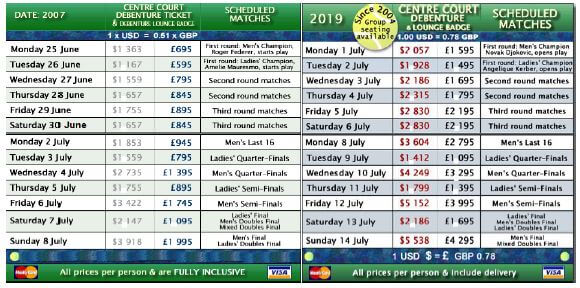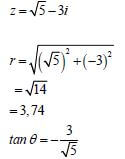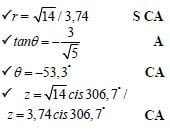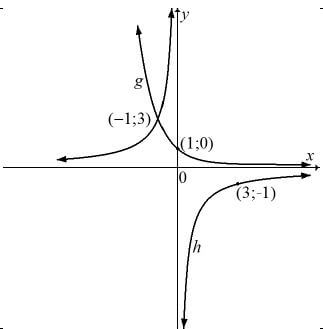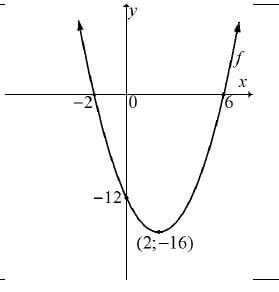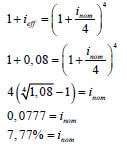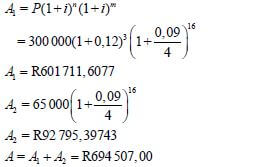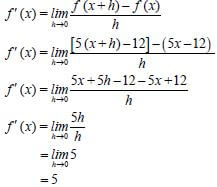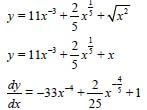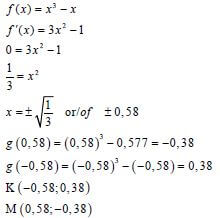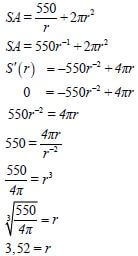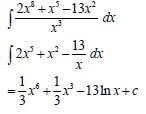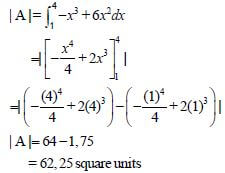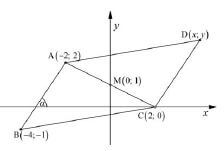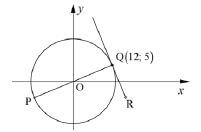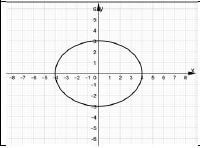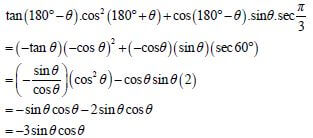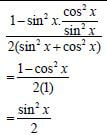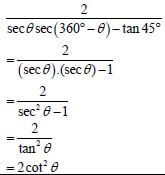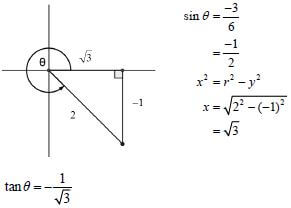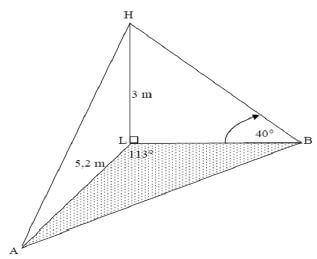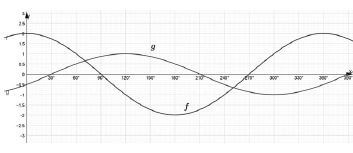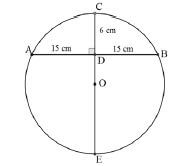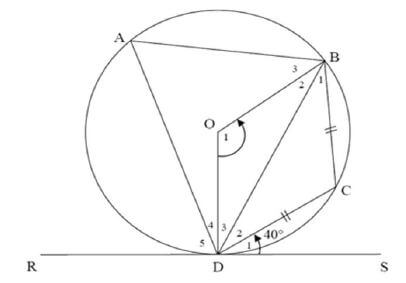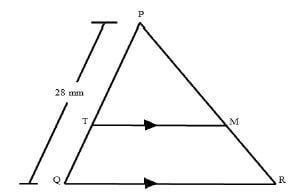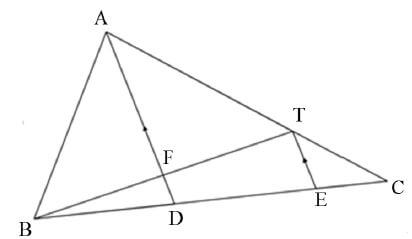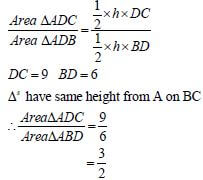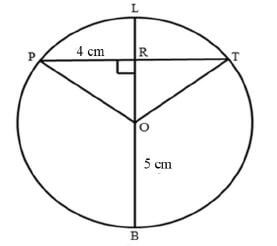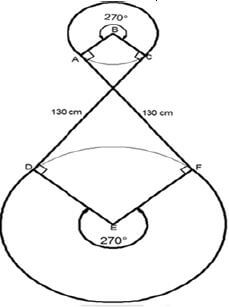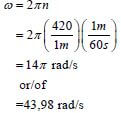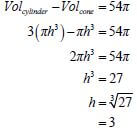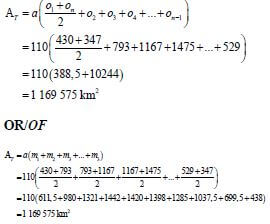Adele
HISTORY PAPER 2 GRADE 12 ADDENDUM - NSC EXAMS PAST PAPERS AND MEMOS JUNE 2019
HISTORY
PAPER 2
GRADE 12
NSC EXAMS PAST PAPERS AND MEMOS JUNE 2019
ADDENDUM
QUESTION 1: HOW DID THE DIFFERENT YOUTH ORGANISATIONS AND LEADERS INFLUENCE THE SOUTH AFRICAN YOUTH IN THE 1970s?
SOURCE 1A
This extract focuses on the roots of Black Consciousness.
The term Black Consciousness stems from American educator Du Bois’s evaluation of the double consciousness of American blacks being taught what they feel inside to be lies about the weakness and cowardice of their race. Du Bois insisted that black people take pride in their blackness as an important step in their personal liberation. [From Footprints in the Sands of Time by the Department of Education] |
SOURCE 1B
The extract below outlines how the South African Student’s Organisation (SASO) mobilised the black South African youth against the apartheid regime in the 1970s.
On one of the programmes that left the BCM's most enduring legacy, Ramphele wrote: ‘The programme for leadership development involved several levels of training and was undertaken as a joint venture by the SASO and BPC ... Weekend “formation schools” were held to train university students in various skills. In addition, an extensive training programme for youth leadership was undertaken to address the needs of high-school and township-based youth clubs in all the provinces of South Africa.’ [From The Road to Democracy in South Africa by M Mzamane et al] |
SOURCE 1C
The following source highlights the impact that the South African Students’ Movement (SASM) had on the youth of Soweto in 1976.
Sibongile Mkhabela, a leader of the South African Students’ Movement (SASM) at Naledi High, recalls that ‘there was serious mobilisation in the schools and this was done mainly through the SASM. SASM members were saying that this situation could not be allowed to continue. That was the build-up to the meeting on 13 June’. [From Soweto, A History by P Bonner and L Segal] |
SOURCE 1D
The following poster was created to pay tribute to Biko after his death in 1977. 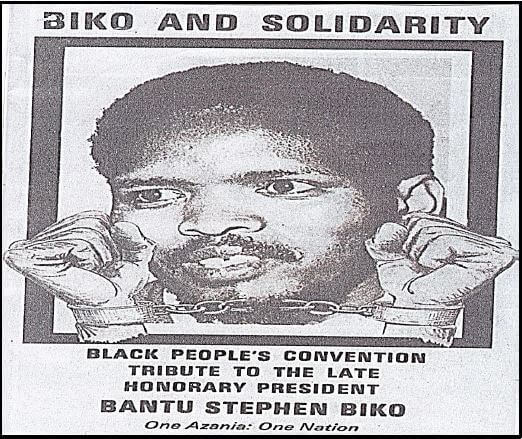
[From Steve Biko by M. Westcott]
QUESTION 2: HOW SUCCESSFUL WAS THE TRUTH AND RECONCILIATION COMMISSION (TRC) IN DEALING WITH SOUTH AFRICA’S DIVIDED PAST?
SOURCE 2A
This extract explains the reasons for the establishment of the TRC.
| After winning the 1994 elections, the ANC had a huge task of building a truly non racial and democratic South Africa, without forgetting its past. As Mandela stated, ‘There was no evil which has been so condemned (rejected) by the world as apartheid and therefore had to a find a way to forgive the perpetrators of the system of apartheid without forgetting the crimes against humanity’. The ANC’s solution to ‘forgiving without forgetting’ was the establishment of the Truth and Reconciliation Commission (TRC) in 1996. The objectives of the TRC were to establish a complete picture as possible of the causes, nature and extent of the gross violation of human rights. It also had to facilitate the granting of amnesty to persons who made full disclosure of all the relevant facts related to acts of violence. The TRC was also charged with making known the fate of victims and restoring their human and civil dignity of such victims, by granting them the opportunity to tell their stories, by recommending reparation [From South Africa’s Transition to Democracy by S. Shaw] |
SOURCE 2B
This is a report of an interview that was conducted with Eugene de Kock after his first appearance before the TRC in September 1997.
De Kock had been an ‘implicated witness’ in the TRC hearing of five white former security policemen in Port Elizabeth who were applying for amnesty for the bombing … The ‘Motherwell Bombing’ was ordered by the commander of the police, General Nic van Rensburg, who had approached De Kock and asked him to ‘make a plan’ in silencing the Motherwell policemen. [From A Human Being Died That Night by P Gobodo-Madikizela] |
SOURCE 2C
This cartoon by Zapiro depicts Eugene de Kock, Craig Williamson and Johan Coetzee as ‘THE 3 TERRORS’ who were involved in the killing of many anti-apartheid activists. 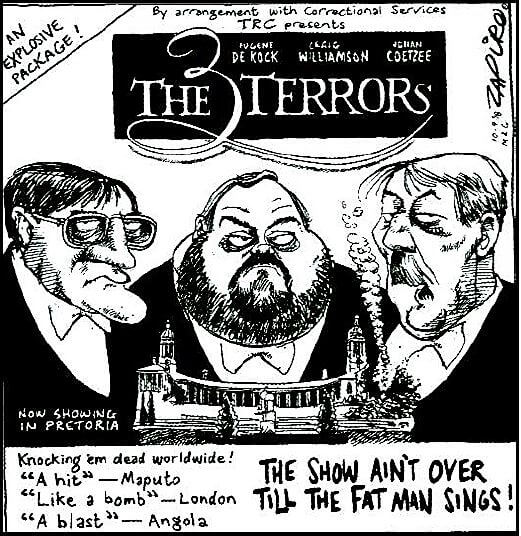
[From Truth and Reconciliation in South Africa: 10 Years On by Charles Villa-Vicencio et al]
SOURCE 2D
This extract by former President Thabo Mbeki focuses on the importance of telling the truth at the TRC hearings.
The great crevices (gaps) in our society which represented the absence of a national consensus about matters that are fundamental to the creation of the new society are also represented by the controversy which seems to have arisen around the work of the Truth and Reconciliation Commission. [From The Life And Times Of Thabo Mbeki by A Hadland and J Rantao] |
ACKNOWLEDGEMENTS
Visual sources and other historical evidence were taken from the following:
Bonner P and Segal L. Soweto, A History
Department of Education, Footprints in the Sands of Time
Gobodo-Madikizela, P. A Human Being Died That Night
Hadland A. and Rantao J, The Life and Times of Thabo Mbeki
Mzamane M. et al, The Road to Democracy in South Africa
Shaw S, South Africa’s Transition to Democracy
Villa-Vicencio et al Truth and Reconciliation in South Africa: 10 Years On
Westcott M, Steve Biko
HISTORY PAPER 2 GRADE 12 QUESTIONS - NSC EXAMS PAST PAPERS AND MEMOS JUNE 2019
HISTORY
PAPER 2
GRADE 12
NSC EXAMS PAST PAPERS AND MEMOS JUNE 2019
INSTRUCTIONS AND INFORMATION
- This question paper consists of SECTION A and SECTION B based on the prescribed content framework in the CAPS document.
SECTION A: SOURCE-BASED QUESTIONS
QUESTION 1: CIVIL RESISTANCE, 1970s TO 1980s: SOUTH AFRICA
QUESTION 2: THE COMING OF DEMOCRACY TO SOUTH AFRICA AND COMING TO TERMS WITH THE PAST
SECTION B: ESSAY QUESTIONS
QUESTION 3: CIVIL RESISTANCE, 1970s TO 1980s: SOUTH AFRICA – THE CRISIS OF APARTHEID IN THE 1980s
QUESTION 4: THE COMING OF DEMOCRACY TO SOUTH AFRICA AND COMING TO TERMS WITH THE PAST: NEGOTIATED SETTLEMENT AND THE GNU
QUESTION 5: THE END OF THE COLD WAR AND A NEW WORLD ORDER: THE EVENTS OF 1989 - SECTION A consists of TWO source-based questions. Source material that is required to answer these questions will be found in the ADDENDUM.
- SECTION B consists of THREE essay questions.
- Answer TWO questions as follows:
At least ONE must be a source-based question and at least ONE must be an essay. - When answering questions, candidates should apply their knowledge, skills and insight.
- A mere rewriting of the sources as answers will disadvantage candidates.
- Number the answers correctly according to the numbering system used in this question paper.
- Write neatly and legibly.
QUESTIONS
SECTION A: SOURCE-BASED QUESTIONS
Answer ONE question from this section. Source material to be used to answer these questions is contained in the ADDENDUM.
QUESTION 1: HOW DID THE DIFFERENT YOUTH ORGANISATIONS AND LEADERS INFLUENCE THE SOUTH AFRICAN YOUTH IN THE 1970s?
Use Sources 1A, 1B, 1C and 1D to answer the following questions.
1.1 Read to Source 1A.
1.1.1 Define the concept ‘Black Consciousness’ in your own words. (1 x 2) (2)
1.1.2 According to the DuBois, what was the most important step in Black people’s personal liberation? (1 x 2) (2)
1.1.3 What, according to the source, was the aims of the global movement of black thinkers? (2 x 1) (2)
1.1.4 Why, do you think, colonialists (conservative white South Africans) would have reacted negatively to the philosophy of Black Consciousness? (2 x 2) (4)
1.1.5 Comment on whether this source would be useful to a historian studying the roots of the Black Consciousness Movement in the 1970s. (2 x 2) (4)
1.2 Refer to Source 1B.
1.2.1 Identify TWO organisations that provided youth programmes for leadership development. (2 x 1) (2)
1.2.2 Using the information in the source and your own knowledge, explain why, the ‘formation schools’ were established in all four provinces. (2 x 2) (4)
1.2.3 Explain in what ways ‘formation schools’ influenced Black South African students to resist oppression. (2 x 2) (4)
1.3 Consult Source 1C.
1.3.1 How, according to Sibongile Mkhabela, did the SASM influence the students of Soweto? (1 x 2) (2)
1.3.2 According to the source, what role did the following leaders play in mobilising the students of Soweto?
- Tsietsi Mashinini (1 x 2) (2)
- Seth Masibuko (1 x 2) (2)
1.3.3 Using the source and your own knowledge, explain why the members of the SASM were against the use of Afrikaans as a medium of instruction in black South African schools. (2 x 2) (4)
1.4 Compare Sources 1B and 1C. Explain how the information in Source 1B supports the evidence in Source 1C regarding the impact that SASO had on the students of Soweto. (2 x 2) (4)
1.5. Refer to Source 1D.
1.5.1 Explain the message that is conveyed by the poster. (1 x 2) (2)
1.5.2 Explain what Biko meant with the following phrase, ‘ONE AZANIA ONE NATION.’ (1 x 2) (2)
1.6 Using the information in the relevant sources and your own knowledge, write a paragraph of about EIGHT lines (about 80 words) explaining how the different youth organisations and leaders influence the youth in the 1970s. (8) [50]
QUESTION 2: HOW SUCCESSFUL WAS THE TRUTH AND RECONCILIATION (TRC) COMMISSION IN DEALING WITH SOUTH AFRICA’S DIVIDED PAST?
Study Sources 2A, 2B, 2C and 2D to answer the following questions. 2.1 Refer to Source 2A.
2.1.1 Define the following concepts in your own words:
- Apartheid (1 x 2) (2)
- Amnesty (1 x 2) (2)
2.1.2 What, according to the source, were the objectives of the TRC? (3 x 1) (3)
2.1.3 Why do you think the ANC decided on a policy of ‘forgive and forget’ after 1994? (2 x 2) (4)
2.1.4 Use your own knowledge to explain whether you consider the TRC to be victim-friendly or perpetrator-friendly. (1 x 2) (2)
2.2 Read Source 2B.
2.2.1 Who, according to the source, was described as the ‘implicated witness’? (1 x 2) (2)
2.2.2 How, according to the information in the source, did De Kock get involved in the 'Motherwell Bombing'? (3 x 1) (3)
2.2.3 Use the information in the source and your own knowledge to explain whether De Kock showed any remorse at the TRC hearings. (2 x 2) (4)
2.2.4 What conclusions can you draw from the attitudes of the two widows after they met with De Kock? Use evidence from the source to support your answer. (1 x 2) (2)
2.3 Consult Source 2C.
2.3.1 Explain the messages the cartoonist wishes to convey in this cartoon. (1 x 2) (2)
2.3.2 Why do you think the cartoonist depicts the Union Buildings in this cartoon? (1 x 2) (2)
2.4 Compare Sources 2B and 2C. Explain the similarities between these two sources regarding De Kock’s testimony at the TRC. (2 x 2) (4)
2.5 Study Source 2D.
2.5.1 How, according to the source, would the hatred and hostility of the past go away? (1 x 2) (2)
2.5.2 Use your own knowledge to explain why the work of the TRC was regarded as controversial. (2 x 2) (4)
2.5.3 Comment on the usefulness of this source to a historian studying the objectives of the TRC. (2 x 2) (4)
2.6 Using the information in the relevant sources and your own knowledge, write a paragraph of about EIGHT lines (about 80 words) explaining how successful the Truth and Reconciliation Commission (TRC) was in dealing with South Africa’s divided past. (8) [50]
SECTION B: ESSAY TYPE QUESTIONS
Answer ONE question from this section.
QUESTION 3: CIVIL RESISTANCE, 1970s TO 1980s: SOUTH AFRICA: THE CRISIS OF APARTHEID IN THE 1980s
‘Boycotts, sanctions and disinvestment are the most important factors that led to the collapse of apartheid.’
Do you agree with this statement? Use relevant examples of various forms of international resistance to apartheid to support your line of argument. [50]
QUESTION 4: THE COMING OF DEMOCRACY TO SOUTH AFRICA AND COMING TO TERMS WITH THE PAST: NEGOTIATED SETTLEMENT AND THE GNU
Critically discuss how South Africa emerged as a democracy from the crisis of the 1990s. Use relevant evidence to support your line of argument. [50]
QUESTION 5: THE COLLAPSE OF COMMUNISM AND THE NEW WORLD ORDER: THE EVENTS OF 1989
The disintegration of the Soviet Union in 1989 served as a catalyst for South Africa to begin its political transformation in the 1990s. To what extent do you agree with this statement? Substantiate your line of argument with relevant evidence. [50]
TOTAL: 100
HISTORY PAPER 1 GRADE 12 QUESTIONS - NSC EXAMS PAST PAPERS AND MEMOS JUNE 2019
HISTORY
PAPER 1
GRADE 12
NSC EXAMS PAST PAPERS AND MEMOS JUNE 2019
INSTRUCTIONS AND INFORMATION
- This question paper consists of SECTION A and SECTION B based on the prescribed content framework in the CAPS document.
SECTION A: SOURCE-BASED QUESTIONS
QUESTION 1: THE COLD WAR: CONTAINMENT AND BRINKMANSHIP – THE CUBAN MISSILE CRISIS
QUESTION 2: INDEPENDENT AFRICA: CASE STUDY – ANGOLA
QUESTION 3: CIVIL SOCIETY PROTESTS FROM THE 1950s TO THE 1970s: THE CIVIL RIGHTS MOVEMENT
SECTION B: ESSAY QUESTIONS
QUESTION 4: EXTENSION OF THE COLD WAR: CASE STUDY – CHINA
QUESTION 5: INDEPENDENT AFRICA: COMPARATIVE CASE STUDY – THE CONGO AND TANZANIA
QUESTION 6: CIVIL SOCIETY PROTESTS FROM THE 1950s TO THE 1970s: THE CIVIL RIGHTS MOVEMENT - SECTION A consists of THREE source-based questions. Source material that is required to answer these questions can be found in the ADDENDUM.
- SECTION B consists of THREE essay questions.
- Answer TWO questions as follows:
4.1 ONE must be a source-based question AND
4.2 ONE must be an essay question - You are advised to spend at least ONE hour per question.
- When answering questions, you should apply your knowledge, skills and insight.
- You will be disadvantaged by merely rewriting the sources as answers.
- Number the answers correctly according to the numbering system used in this question paper.
- Write clearly and neatly.
QUESTIONS
SECTION A: SOURCE-BASED QUESTIONS
Answer ONE question from this section. Source material that is required to answer these questions can be found in the ADDENDUM.
QUESTION 1: HOW DID THE CUBAN MISSILE CRISIS LEAD TO COLD WAR TENSIONS BETWEEN THE USA AND USSR IN THE 1960s?
Study Sources 1A, 1B, 1C and 1D to answer the questions that follow. 1.1 Study Source 1A.
1.1.1 Which country, according to the source, was under attack? (1 x 1) (1)
1.1.2 What evidence in the source suggests that America was behind the invasion? (2 x 1) (2)
1.1.3 Using the source and your own knowledge, explain why Khrushchev was determined to help Cuba. (2 x 2) (4)
1.1.4 Who were the ‘armed bands’ that Khrushchev referred to? (1 x 1) (1) 1.2 Refer to Source 1B.
1.2.1 Find a historical concept from the source that best fits each of the following definitions:
- A political system where the means of production is owned by the state (1 x 2) (2)
- A political system where the powers are vested in the hands of one person only (1 x 2) (2)
1.2.2 Provide TWO quotes from the source that suggest that the USA was not responsible for the Bay of Pigs invasion. (2 x 1) (2)
1.2.3 With reference to Sources 1A and 1B, explain why the viewpoints of Khrushchev and Kennedy differ with regards to the Bay of Pigs Invasion. (2 x 2) (4)
1.2.4 Compare Sources 1A and 1B. How do the two sources contradict each other with regards to the reasons for the Bay of Pigs Invasion? (2 x 2) (4)
1.2.5 Use your own knowledge to explain whether the Bay of Pigs Invasion was successful. (1 x 1) (1)
1.3 Read Source 1C.
1.3.1 List any TWO counties that had American nuclear weapons capable of destroying Russia. (2 x 1) (2)
1.3.2 Quote ONE reason as to why Russia decided to place nuclear missiles in Cuba. (1 x 1) (1)
1.3.3 In your opinion, why did Kennedy not invade Cuba immediately to destroy the missiles? (2 x 2) (4)
1.4 Consult Source 1D.
1.4.1 Explain why this source is biased against Khrushchev. Use visual clues from the source to support your answer. (2 x 2) (4)
1.4.2 Using the source and your own knowledge, explain how the Cuban Missile Crisis was resolved. (2 x 2) (4)
1.4.3 Use your own knowledge to explain the impact of the Cuban Missile Crisis on the political career of Khrushchev. (2 x 2) (4)
1.5 Using the information in the relevant sources and your own knowledge, write a paragraph of about EIGHT lines (80 words) explaining how the Cuban Missile Crisis led to tensions between the USA and the USSR in the 1960s. (8) [50]
QUESTION 2: WHY DID CUBA BECOME INVOLVED IN THE ANGOLAN CIVIL WAR?
Study Sources 2A, 2B, 2C and 2D and answer the following questions.
2.1 Study Source 2A.
2.1.1 List TWO reasons Deutschman proposes for Cuba’s involvement in the Angolan Civil War. (2 x 1) (2)
2.1.2 Provide TWO quotes from paragraph 1 that proves that Cuba did not get involved in Angola for material interests. (2 x 1) (2)
2.1.3 Explain what Risquet meant when he said, ‘Proof of that is that when our presence is no longer needed, we will withdraw’. (2 x 2) (4)
2.1.4 Was Deutschman correct to believe that Cuba was acting as a puppet of the Soviet Union? Support your answer with TWO comprehensive points from paragraph 3. (2 x 2) (4)
2.2 Refer to Source 2B.
2.2.1 Provide TWO quotes from paragraph 1 which suggest that Cuba and Angola have a common heritage. (2 x 1) (2)
2.2.2 Find a historical concept in paragraph 3 that best fits each of the following definitions:
- Unfair treatment of people based on the colour of their skin (1 x 2) (2)
- A policy of extending a country’s political and economic power over other countries through colonisation (1 x 2) (2)
2.2.3 Comment on Castro’s statement that, ‘Yankee imperialism, without scruples (conscience) of any kind, has launched South African mercenary troops in an attempt to crush Angola’s independence and is now outraged by our help to Angola …’. (2 x 2) (4)
2.3 Read Source 2C.
2.3.1 What, according to the source posed a bigger threat to South Africa, other than the emergence of an independent black African nation? (Paragraph 1) (1 x 2) (2)
2.3.2 Use the source and your own knowledge to explain why SA became involved in the Angolan Civil War. (2 x 2) (4)
2.3.3 List any TWO reasons why South Africa believed that Cuba should not control Southern Africa. (Paragraph 3) (2 x 1) (2)
2.4 Study Sources 2B and 2C. Explain why these two sources present such different viewpoints with regards to Cuba’s involvement in Angola. Use evidence from both sources to support your answer. (2 x 2) (4)
2.5 Consult Source 2D.
2.5.1 What messages do the picture convey about the relationship between Cuba and Angola? Support your answer with reference to the visual clues in the source. (2 x 2) (4)
2.5.2 Comment on the usefulness of this source for a historian researching the involvement of Cuba in the Angolan Civil War. (2 x 2) (4)
2.6 Using the information in the relevant sources and your own knowledge, write a paragraph of about EIGHT lines (about 80 words) explaining the reasons for Cuba’s involvement in the Angolan Civil War. (8) [50]
QUESTION 3: WHAT WERE THE REASONS FOR THE FORMATION OF THE BLACK POWER MOVEMENT IN THE USA IN THE 1960s?
Study Sources 3A, 3B, 3C and 3D and answer the following questions.
3.1 Study Source 3A.
3.1.1 Provide FOUR words from the source that suggest that Black people were ill-treated by police in California. (Paragraph 1) (4 x 1) (4)
3.1.2 List any TWO reasons why the Black Panther Party felt that the American government was racist towards people of colour. (Paragraph 2) (2 x 1) (2)
3.1.3 Explain why you think the Black Panther Party was correct to advocate a policy of self-defence against white supremacy. (Paragraph 3) (2 x 2) (4)
3.1.4 Comment on the statement that, ‘The black communities of America must rise up as one man to halt the progression of a trend that leads inevitably to their total destruction.’ (1 x 2) (2)
3.2 Refer to Source 3B.
3.2.1 Why, according to the source, were the police watching the members of the Black Power Movement? (Paragraph 1) (1 x 1) (1)
3.2.2 What evidence in the source suggests that the Black Power Movement received massive support from the Black community? (Paragraph 1) (2 x 1) (2)
3.2.3 What do you think Malcolm X meant when he said, ‘We were dealing with power to all the people not just black power’? (1 x 2) (2)
3.2.4 Do you think that the Black Power Movement was established for self-defence only? Support your answer with TWO comprehensive points from paragraph 3. (2 x 2) (4)
3.3 Read Source 1C.
3.3.1 What, according to Malcolm X, was the basis for the success of both the American and French Revolutions? (Paragraph 1) (1 x 1) (1)
3.3.2 Find a historical concept that best fits each of the following definitions:
- A violent overthrow of the government (Paragraph 1) (1 x 2) (2)
- The end of separation between races (Paragraph 4) (1 x 2) (2)
3.3.3 Use the information in the source and your own knowledge to explain Malcolm X’s stance on violence. (2 x 2) (4)
3.4 Compare Source 3A to Source 3C. How does the information in Source 3A support the evidence in Source 3C with regards to the Black Power Movement’s reasons for self-defence? (2 x 2) (4)
3.5 Consult Source 3D.
3.5.1 What can you learn about the relationship between Fidel Castro and Malcolm X? (2 x 2) (4)
3.5.2 Explain the usefulness of this source for historians studying the reasons for the American dislike of the Black Power Movement. (2 x 2) (4)
3.6 Using the information in the relevant sources and your own knowledge, write a paragraph of about EIGHT lines (about 80 words) explaining the reasons for the formation of the Black Power Movement in the USA in the 1960s. (8) [50]
TOTAL SECTION A: 50
SECTION B: ESSAY QUESTIONS
Answer ONE question from this section.
Your essay should be about THREE pages long.
QUESTION 4: CASE STUDY – CHINA
Mao Zedong’s policies of the Great Leap Forward and the Cultural Revolution was an attempt to strengthen communism and to transform China into a communist superpower.
Explain to what extent Mao was successful in achieving this goal between 1958 and 1976. [50]
QUESTION 5: INDEPENDENCE IN AFRICA IN THE 1960s AND 1970s – CONGO AND TANZANIA
With reference to the social, economic and political policies implemented by Julius Nyerere and Mobuto Sese Seko after independence, critically assess whether they were successful in their aims of economic independence and self-reliance. [50]
QUESTION 6: CIVIL SOCIETY PROTESTS FROM THE 1950s TO THE 1970s – CIVIL RIGHTS MOVEMENT
‘The protest actions of the Civil Rights Movement led to the termination of the most obvious forms of racial discrimination in the USA in the 1960s.’
Do you agree with the statement? Substantiate your answer with relevant historical evidence. [50]
TOTAL SECTION B: 50
GRAND TOTAL: 100
HISTORY PAPER 2 GRADE 12 MEMORANDUM - NSC EXAMS PAST PAPERS AND MEMOS JUNE 2019
HISTORY
PAPER 2
GRADE 12
NSC EXAMS PAST PAPERS AND MEMOS JUNE 2019
1. SOURCE-BASED QUESTIONS
1.1 The following cognitive levels were used to develop source-based questions:
COGNITIVE LEVELS | HISTORICAL SKILLS | WEIGHTING OF QUESTIONS |
LEVEL 1 |
| 30% (15) |
LEVEL 2 |
| 40% (20) |
LEVEL 3 |
| 30% (15) |
1.2 The information below indicates how source-based questions are assessed:
|
1.3 Assessment procedures for source-based questions
- Use a tick (✔) for each correct answer
- Pay attention to the mark scheme e.g. (2 × 2) which translates to two reasons and is given two marks each (✔✔ ✔✔); (1 × 2) which translates to one reason and is given two marks (✔✔)
- If a question carries 4 marks then indicate by placing 4 ticks (✔✔✔✔)
Paragraph question
Paragraphs are to be assessed globally (holistically). Both the content and structure of the paragraph must be taken into account when awarding a mark. The following steps must be used when assessing a response to a paragraph question:
- Read the paragraph and place a bullet ( . ) at each point within the text where the candidate has used relevant evidence to address the question.
- Re-read the paragraph to evaluate the extent to which the candidate has been able to use relevant evidence to write a paragraph.
- At the end of the paragraph indicate the ticks (√) that the candidate has been awarded for the paragraph; as well as the level (1, 2 or 3) as indicated in the holistic rubric and a brief comment e.g. ___________ ˖ __________________________ ˖ _________________ _________________ ˖ __________________________ ˖ ___________ √√√√ Level 2
Used mostly relevant evidence to write a basic paragraph
- Count all the ticks for the source-based question and then write the mark on the right-hand bottom margin e.g. 32/50
- Ensure that the total mark is transferred accurately to the front/back cover the answer script.
2. ESSAY QUESTIONS
2.1 The essay questions require candidates to:
- Be able to structure their argument in a logical and coherent manner. They need to select, organise and connect the relevant information so that they are able to present a reasonable sequence of facts or an effective argument to answer the question posed. It is essential that an essay has an introduction, a coherent and balanced body of evidence and a conclusion.
2.2 Marking of essay questions
- Markers must be aware that the content of the answer will be guided by the textbooks in use at the particular centre.
- Candidates may have any other relevant introduction and/or conclusion than those included in a specific essay marking guideline for a specific essay.
- When assessing open-ended source-based questions, learners should be credited for Any other relevant answers.
2.3 Global assessment of the essay
The essay will be assessed holistically (globally). This approach requires the teacher to score the overall product as a whole, without scoring the component parts separately. This approach encourages the learner to offer an individual opinion by using selected factual evidence to support an argument. The learner will not be required to simply regurgitate 'facts' in order to achieve a high mark. This approach discourages learners from preparing ‘model’ answers and reproducing them without taking into account the specific requirements of the question. Holistic marking of the essay credits learners’ opinions supported by evidence. Holistic assessment, unlike content-based marking, does not penalise language inadequacies as the emphasis is on the following:
- The construction of argument
- The appropriate selection of factual evidence to support such argument
- The learner’s interpretation of the question.
2.4 Assessment procedures of the essay
2.4.1 Keep the synopsis in mind when assessing the essay.
2.4.2 During the reading of the essay ticks need to be awarded for a relevant introduction (indicated by a bullet in the marking guideline/memorandum), each of the main points/aspects that is properly contextualised (also indicated by bullets in the marking guideline/memorandum) and a relevant conclusion (indicated by a bullet in the marking guideline) e.g. in an answer where there are 5 main points there will be 7 ticks.
2.4.3 Keep the PEEL structure in mind when assessing an essay.
P | Point: The candidate introduces the essay by taking a line of argument/making a major point. |
E | Explanation: The candidate should explain in more detail what the main point is all about and how it relates to the question posed (line of argument). |
E | Example: The candidates should answer the question by selecting content that is relevant to the line of argument. Relevant examples should be given to sustain the line of argument. |
L | Link: Candidates should ensure that the line of argument is sustained throughout the essay and is written coherently. |
2.4.4 The following symbols MUST be used when assessing an essay:
- Introduction, main aspects and conclusion not properly contextualised ^
- Wrong statement _________________
- Irrelevant statement |
|
| - Repetition R
- Analysis A√
- Interpretation I√
- Line of argument LOA
2.5 The matrix
2.5.1 Use of the matrix in the marking of essays.
In the marking of essays, the criteria as provided in the matrix should be used. When assessing the essay note both the content and presentation. At the point of intersection of the content and presentation based on the seven competency levels, a mark should be awarded.
(a) The first reading of essays will be to determine to what extent the main aspects have been covered and to allocate the content level (on the matrix).
C | LEVEL 4 | |
(b) The second reading of essays will relate to the level (on the matrix) of presentation.
C | LEVEL 4 | |
P | LEVEL 3 |
(c) Allocate an overall mark with the use of the matrix.
C | LEVEL 4 | }26–27 |
P | LEVEL 3 |
MARKING MATRIC FOR ESSAY – TOTAL: 50
PRESENTATION
CONTENT | LEVEL 7
| LEVEL 6
| LEVEL 5
| LEVEL 4
| LEVEL 3
| LEVEL 2
| LEVEL 1*
|
LEVEL 7
| 47–50 | 43–46 | |||||
LEVEL 6
| 43–46 | 40–42 | 38–39 | ||||
LEVEL 5
| 38–39 | 36–37 | 34–35 | 30–33 | 28–29 | ||
LEVEL 4
| 30–33 | 28–29 | 26–27 | ||||
LEVEL 3
| 26–27 | 24–25 | 20–23 | ||||
LEVEL 2
| 20–23 | 18–19 | 14–17 | ||||
LEVEL 1*
| 14–17 | 0–13 |
*Guidelines for allocating a mark for Level 1:
- Question not addressed at all/totally irrelevant content; no attempt to structure the essay = 0
- Answer includes basic and generally irrelevant information; no attempt to structure the essay = 1–6
- Question inadequately addressed and vague; little attempt to structure the essay = 7–13
SECTION A: SOURCE-BASED QUESTIONS
QUESTION 1: HOW DID THE DIFFERENT YOUTH ORGNISATIONS AND LEADERS INFLUENCE THE SOUTH AFRICAN YOUTH IN THE 1970s?
1.1 1.1.1 [Explanation of historical concept from Source 1A – L1]
- Black Consciousness is a philosophy based on the belief that liberation for blacks would only be attained if they removed the shackles of inferiority and fear
- Black Consciousness is the belief in oneself as a black/self – reliance/pride
- Any other relevant response (1 x 2) (2)
1.1.2 [Extraction of evidence from Source 1A – L1]
- Black people take pride in their in their blackness (1 x 2) (2)
1.1.3 [Extraction of evidence from Source 1A – L1]
- Restore black consciousness
- Restore African consciousness (2 x 1) (2)
1.1.4 [Interpretation of evidence from Source 1A – L2]
- Black Consciousness (BC) revived a sense of identity
- It inspired the blacks to fight the apartheid system
- Any other relevant response (2 x 2) (4)
1.1.5 [Ascertain the usefulness of Source 1A – L3]
The source is useful because:
- It highlights the involvement of African American leaders influence on Biko
- It emphasises the need for Black people to change their mindset
- It shows the need for them to be proud as a human being, being black and having some dignity.
- Any other relevant response (Any 2 x 2) (4)
1.2 1.2.1 [Extraction of evidence from Source 1B – L1]
- BPC
- SASO (2 x 1) (2)
1.2.2 [Interpretation of evidence from Source 1B – L2]
- To reach the masses in all provinces
- To create/identify leaders in all provinces
- To spread the ideas of Black Consciousness across South Africa
- To equip university students in various skills
- To cater for the needs of high-schools and township-based youth
- Any other relevant response (Any 2 x 2) (4)
1.2.3 [Interpretation of evidence from Source 1B – L2]
- Taught Black South African students to be self-reliant
- Instilled Black pride and independence
- Taking responsibility for their well-being
- Created leadership for the liberation movement
- Acquisition of skills
- Any other relevant response (Any 2 x 2) (4)
1.3 1.3.1 [Extraction of evidence from Source 1C – L1]
- There was serious mobilisation in the schools (1 x 2) (2)
1.3.2 Extraction of evidence from Source 1C – L1]
- Proposed a mass demonstration against Afrikaans (1 x 2) (2)
- Led the initial class boycott at Orlando West Junior Secondary School (1 x 2) (2)
1.3.3 [Interpretation of evidence from Source 1C – L2]
- Afrikaans was the oppressor’s language
- Students and teachers were not familiar with the language
- Resulted in demotivation, drop outs and failure among black South African learners.
- Any other relevant response (Any 2 x 2) (4)
1.4 [Comparison of sources and ascertaining similarities between Sources 1B and 1C–L3]
- Source 1B indicates the training of leaders in various political skills and Source 1C shows the leaders taking action against oppression.
- Both sources highlight the influence that the student movements had on the youth in the 1970s
- Source 1B influenced students to resist Bantu Education and Source 1C shows how students resisted Bantu Education.
- Any other relevant response (Any 2 x 2) (4)
1.5 1.5.1 [Interpretation of evidence from Source 1D – L2]
- Biko believed in one nation for the country which he called Azania
- People still believed in Steve Biko and the Black Consciousness
Movement
- Motivate people to continue the fight against apartheid
- To commemorate Biko for his contribution in the fight against apartheid
- Any other relevant response (Any 1 x 2) (2)
1.5.2 [Interpretation of evidence from Source 1D – L2]
- Our country should belong to everyone that lives in it
- The countries name should be changed to Azania.
- Any other relevant response (Any 1 x 2) (2)
1.6 [Interpretation, evaluation and synthesis of evidence from relevant sources – L3]
Candidates could include the following aspects in their responses:
- Black Consciousness expressed black pride and the determination to rise against oppression (Source 1A)
- Created independence/self- reliance amongst black South Africans (Source 1A)
- The ideas of Black Consciousness spread across schools which conscientised learners to reject Bantu Education (Source 1B)
- Mobilised students to resist Afrikaans as a medium of instruction (Sources 1C and 1D)
- BC encouraged students to embark on mass demonstrations/class boycotts against Bantu Education (Source 1C)
- Encouraged black South African youth to stand up for their rights (own knowledge)
- The philosophy of Black Consciousness served to politically conscientise South Africans (own knowledge)
- Biko spoke about the new South Africa which he called Azania (Source 1D)
- People still believe in Biko and Black Consciousness (Source 1D).
- Any other relevant response (8)
Use the following rubric to allocate marks:
LEVEL 1 |
| MARKS 0–2 |
LEVEL 2 |
| MARKS 3–5 |
LEVEL 3 |
| MARKS 6–8 |
(8) [50]
QUESTION 2: HOW SUCCESSFUL WAS THE TRUTH AND RECONCILIATION COMMISSION (TRC) IN DEALING WITH SOUTH AFRICA’S DIVIDED PAST?
2.1 2.1.1 [Explanation of historical concepts from Source 2A – L1]
(a) Apartheid
- Discrimination of people on the basis of their colour, race and gender
- Separation of races politically, economically and socially
- Any other relevant explanation (Any 1 x 2) (2)
(b) Amnesty
- Is the granting of official pardon for people that committed politically related offences during apartheid
- Any other relevant explanation (Any 1 x 2) (2)
2.1.2 [Extraction of information from Source 2A – L1]
- To bring to light the causes, nature and extent of gross human violations
- Granting of amnesty
- Disclosure of all relevant facts related to acts of violence.
- Restoring human and civil dignity
- Recommending reparation/amnesty
- Any other relevant response (Any 3 x 1) (3)
2.1.3 [Interpretation of evidence from Source 2A – L2]
- Much hatred/mistrust existed between different races
- To make the new dispensation work in South Africa
- To prevent further violence that has plagued South Africa for years
- To secure the survival of the new democracy
- Any other relevant response (Any 2 x 2) (4)
2.1.4 [Interpretation of evidence from Source 2A – L2]
- Victim-friendly: Allowed them to find closure and an opportunity to forgive
OR
- Perpetrator-friendly: They were not jailed for their actions/they were granted amnesty (1 x 2) (2)
2.2 2.2.1 [Extraction of evidence from Source 2B – L1]
- Eugene De Kock (1 x 2) (2)
2.2.2 [Extraction of evidence from Source 2B – L1]
- De Kock was approached by General van Rensburg to kill the Motherwell policemen
- De Kock approached the technical division of the Pretoria police
- He had a bomb made (3 x 1) (3)
2.2.3 [Interpretation of evidence of from Source 2B – L2]
- Candidates need to take a stance and support their response with relevant answers
- YES
- He made an appeal to meet with the widows of the victims
- He wanted to apologise
- He acknowledged their pain
- Any other relevant response (Any 2 x 2) (4)
2.2.4 [Interpretation of evidence from Source 2B – L2]
- Emotional
- Forgiveness
- Tearful
- Any other relevant response (Any 1 x 2) (4)
2.3 2.3.1 [Interpretation of evidence from Source 2C – L2]
- It depicts Eugene de Kock, Craig Williamson and Johan Coetzee appearing before the Amnesty Commission of the TRC
- The Amnesty Commission sat at the Union buildings in Pretoria
- They were responsible for the murders of many anti-apartheid activists
- They have committed many political crimes in different counties
- Any other relevant response (Any 1 x 2) (2)
2.3.2 [Interpretation of evidence from Source 2C – L2]
- Seat of power of the government which was guilty of human rights abuses
- It represented the leadership of the government who gave orders
- They were all ex government officials.
- Any other relevant response (Any 1 x 2) (2)
2.4 [Comparison of Source 2B and Source 2C – L3]
- Source 2B indicates that De Kock was an implicated witness in the TRC hearings. Source 2C shows that De Kock appears before the TRC at the Union building
- Both sources refer to bombs being used to get rid of state enemies
- In Source 2B De Kock reveals the truth about the Motherwell bombing and in Source 2C the truth unfolds/The show ain’t over till the fat man sings
- Any other relevant response (Any 2 x 2) (4)
2.5 2.5.1 [Extraction of evidence from Source 1D – L1]
- The truth is being told of what happened (1 x 2) (2)
2.5.2 [Interpretation of evidence from Source 2D – L2]
- The issue on the granting of amnesty
- Some victims wanted perpetrators to be punished for their crimes
- Some people who were guilty of gross human violations refused to appear before the TRC
- Some perpetrators did not tell the truth and showed no remorse
- Any other relevant response (Any 2 x 2) (4)
2.5.3 [Evaluating the usefulness of Source 2D – L3]
The source is useful because:
- Hatred and animosities of the past would go away/heal the wounds of the past
- It would restore the respect (worth) of the South African nation
- It would be an admission that something wrong was done
- Bring about reconciliation/unity
- Any other relevant response (Any 2 x 2) (4)
2.6 [Interpretation, evaluation and synthesis of evidence from relevant sources – L3]
Candidates could include the following aspects in their response:
- After winning the 1994 elections, the ANC established the TRC (Source 2A)
- Objectives were to establish causes, nature and extent of gross human violations (Source 2A)
- Granting of amnesty to those that made full disclosure (Source 2 A)
- They were able to come forward and tell their stories (Source 2A)
- Eugene de Kock was the first implicated witness that applied for amnesty (Source 2B)
- The mothers of the victims in the Motherwell Bombing forgave him (Source 2B)
- They wanted De Kock to have a future (Source 2B)
- Three of them were involved in atrocities (Source 2C)
- They also appeared before the TRC (Source 2C)
- Mbeki gives reasons as to why it is important to tell the truth at the TRC (Source 2D)
- Telling the truth is as painful as hurting the victims (Source 2D)
- Any other relevant response
Use the following rubric to allocate marks:
LEVEL 1 |
| MARKS 0–2 |
LEVEL 2 |
| MARKS 3–5 |
LEVEL 3 |
| MARKS 6–8 |
(8) [50]
SECTION B: ESSAY QUESTIONS
QUESTION 3: CIVIL RESISTANCE, 1970s TO 1980s: SOUTH AFRICA: THE CRISIS OF APARTHEID IN THE 1980s
[Plan and construct an original argument based on relevant evidence using analytical and interpretative skills]
SYNOPSIS
Candidates should explain to what extent the international anti-apartheid movement played a major role in ensuring the eventual downfall of the apartheid regime in the 1980s. Candidates need to use relevant examples that the international civil resistance movement used against the apartheid regime.
MAIN ASPECTS
Candidates should include the following aspects in their response:
- Introduction: Candidates need to explain to what extent the international anti apartheid movement was responsible for the eventual downfall of apartheid regime.
ELABORATION
- Formation and role of the Anti-Apartheid Movement (AAM) in the United Kingdom (background)
- Formation and role of Irish Anti-Apartheid Movement (IAAM) (background)
- IDAF: financial backing to activists
- PW Botha's attempts at reforming apartheid by introducing the Tri-Cameral parliamentary system in 1983
- PW Botha's Rubicon Speech of 1985 forced the international community into action which embarked on various forms of boycotts, sanctions and disinvestments against the apartheid regime
- Sport Boycotts: The role of the South African Non-Racial Olympic Committee (SANROC) campaigned against discrimination in sport/against participants of whites only South African teams in international sporting events
- The role of Halt All Racial Tours (HART) (staged protest action against the 'racist' Springbok rugby tour in New Zealand in 1981)
- The role of the South African Council on Sport (SACOS) (established political links with the UDF and COSATU and they insisted that sports boycotts be maintained until apartheid ended - their slogan 'No normal sport in an abnormal society')
- By the late 1980s South Africa was banned from 90% of world sport
- Cultural Boycotts: In 1985, US artists protested against apartheid and refused to perform in South Africa
- Raised money for liberation movements (In 1986 the Freedom Festival in London;
- Musicians expressed their solidarity with freedom loving South Africans
- Academic Boycotts: International scholars refused to travel to South Africa/ International publishers refused to publish South African manuscripts and grant access to information/International conferences barred South African scholars/ Institutions abroad denied South Africa academics access and refused to recognise South African degrees
- Consumer boycotts: OPEC placed an embargo on oil sales to South Africa (South Africa experienced a recession in 1980s)/Irish workers refused to handle fruits from SA/Imports of raw materials from South Africa – coal, iron, steel – were banned
- Disinvestments: In 1980s foreign investments dropped by 30%; by 1980 Britain already disinvested from Simon’s Town naval dockyard; General Motors and Barclays Bank pulled out of SA/In the 1980s SAs economy struggled as investors left the country
- The effects of AAM protests had a negative effect on the South African government
- Between 1985 and 1990 over 200 US companies pulled out of South Africa, University of California withdrew investments of three billion dollars from South Africa
- Sanctions: (In 1980s the Sullivan Principle, workers of all USA companies should be treated equally) In 1985 the US Bank – Chase Manhattan Bank cut ties with South Africa; the Johannesburg Stock Exchange (JSE) closed for 4 days. The value of the rand dropped by 35% from 54 to 34 cents to the dollar), in 1986 the US Congress passed a law that banned all new investments and loans in SA; big corporations such as General Electric, Pepsi Cola, General Motors, Mobil and IBM stopped their activities in South Africa; USA threatened to stop weapon sales to countries which provided weapons to South Africa; in 1986 the Anti-Apartheid Law of the USA caused Europe and Japan to introduce sanctions against South Africa/International banks lost confidence in South Africa's economy
- In 1982, United Nations (UN) condemned apartheid and called for total sanctions against South Africa
- In 1985, the European Economic Community banned new investments in South Africa
- In 1988 one fifth of British companies withdrew their businesses from South Africa because of pressure from shareholders/Barclays Bank, sold their shares due to pressure of the British public/The South African economy kept stagnating and produced a growth of only 1,1%
- Release Mandela Campaign: (Wembley Stadium/United Nations/UN Security Council and UN General Assembly called for the release of Nelson Mandela) ∙ The Role of international trade unions: (The AAM in Europe and Australia; Liverpool dockworkers; Finland's Transport Workers Union imposed a ban on trade with South Africa)
- This resulted in SA experiencing great economic difficulties and they were forced to begin negotiations with liberation organisations in South Africa
- The role of the Front-Line states
- Any other relevant response
- Conclusion: Candidates need to tie up their argument with a relevant conclusion. [50]
QUESTION 4: THE COMING OF DEMOCRACY TO SOUTH AFRICA AND COMING TO TERMS WITH THE PAST
[Plan and construct an original argument based on relevant evidence using analytical and interpretative skills.]
SYNOPSIS
Candidates need to critically discuss how South Africa emerged as a democracy from the crisis of the 1990s. Relevant examples to South Africa’s road to democracy must be discussed.
MAIN ASPECTS
Candidates should include the following aspects in their essays:
- Introduction: Candidates need to critically discuss the different role-players in creating conditions for South Africa’s road to democracy from 1990 to 1994.
ELABORATION
Focus on different role players in the following key historical events and turning points:
- Release of Mandela and unbanning of ANC, PAC and SACP
- The process of negotiations (i.e. Groote Schuur Minute, Pretoria Minute)
- Suspension of the armed struggle
- CODESA 1
- Referendum
- CODESA 2
- Record of Understanding
- Increased violence – Rolling mass action (i.e. Boipatong, Bhisho, etc.)
- Goldstone Commission
- Multi party negotiations
- Death of Hani – call for peace
- Storming of the World Trade Centre, etc.
- 1994 election – cast ballot in KZN
- ANC won elections and Mandela became the first black South African president
- Any other relevant response
- Conclusion: Candidates need to tie up their argument with a relevant conclusion. [50]
QUESTION 5: THE END OF THE COLD WAR AND A NEW WORLD ORDER: THE EVENTS OF 1989
[Plan and construct an original argument based on relevant evidence using analytical and interpretative skills]
SYNOPSIS
Candidates need to state whether they agree or disagree with the statement. They need to indicate whether the disintegration of the Soviet Union in 1989 served as a catalyst for South Africa to begin its political transformation in the 1990s. Candidates must support their given line of argument with relevant historical evidence.
MAIN ASPECTS
Candidates should include the following aspects in their response:
- Introduction: Candidates need to indicate whether the disintegration of the Soviet Union in 1989 served as a catalyst for the political transformation that occurred in South Africa in the 1990s.
ELABORATION
In agreeing with the assertion, candidates could include the following points in their answer.
- The impact of the disintegration of the Soviet Union in 1989 on South Africa
- Gorbachev’s reform policies of Glasnost and Perestroika
- The communist regimes in Eastern Europe collapsed
- The Berlin Wall had fallen
- Changes in the world contributed to the end of apartheid
- The collapse of the USSR deprived the ANC of its main source of support (financial; military and moral and its consequences)
- The National Party claim that it was protecting South Africa from a communist onslaught became unrealistic
- Western world powers supported the move that South Africa resolve its problems peacefully and democratically
- It became evident the National Party government could not maintain white supremacy indefinitely
- Influential National Party members started to realise that apartheid was not the answer to the needs of white capitalist development
- The Battle of Cuito Cuanavale and its consequences
- The security forces and state of emergency had not stopped township revolts
- By the late 1980s South Africa was in a state of economic depression
- The role of business leaders in South Africa’s political transformation
- PW Botha suffered a stroke and was succeeded by FW De Klerk
- FW de Klerk started to accept that the black South African struggle against apartheid was not a conspiracy directed from Moscow
- This enabled De Klerk to engage in discussions with the liberation organisations
- On 2 February 1990, De Klerk announced ‘a new and just constitutional dispensation’
- This signalled the end of apartheid
- Any other relevant response
- Conclusion: Candidates need to tie up their argument with a relevant conclusion. [50]
TOTAL: 100
HISTORY PAPER 1 GRADE 12 MEMORANDUM - NSC EXAMS PAST PAPERS AND MEMOS JUNE 2019
HISTORY
PAPER 1
GRADE 12
NSC EXAMS PAST PAPERS AND MEMOS JUNE 2019
1. SOURCE-BASED QUESTIONS
1.1 The following cognitive levels were used to develop source-based questions:
COGNITIVE LEVELS | HISTORICAL SKILLS | WEIGHTING OF QUESTIONS |
LEVEL 1 |
| 30% (15) |
LEVEL 2 |
| 40% (20) |
LEVEL 3 |
| 30% (15) |
1.2 The information below indicates how source-based questions are assessed:
|
1.3 Assessment procedures for source-based questions
- Use a tick (✔) for each correct answer
- Pay attention to the mark scheme e.g. (2 × 2) which translates to two reasons and is given two marks each (✔✔ ✔✔); (1 × 2) which translates to one reason and is given two marks (✔✔)
- If a question carries 4 marks then indicate by placing 4 ticks (✔✔✔✔)
Paragraph question
Paragraphs are to be assessed globally (holistically). Both the content and structure of the paragraph must be taken into account when awarding a mark. The following steps must be used when assessing a response to a paragraph question:
- Read the paragraph and place a bullet ( . ) at each point within the text where the candidate has used relevant evidence to address the question.
- Re-read the paragraph to evaluate the extent to which the candidate has been able to use relevant evidence to write a paragraph.
- At the end of the paragraph indicate the ticks (√) that the candidate has been awarded for the paragraph; as well as the level (1, 2 or 3) as indicated in the holistic rubric and a brief comment e.g. ___________ ˖ __________________________ ˖ _________________ _________________ ˖ __________________________ ˖ ___________ √√√√ Level 2
Used mostly relevant evidence to write a basic paragraph
- Count all the ticks for the source-based question and then write the mark on the right-hand bottom margin e.g. 32/50
- Ensure that the total mark is transferred accurately to the front/back cover the answer script.
2. ESSAY QUESTIONS
2.1 The essay questions require candidates to:
- Be able to structure their argument in a logical and coherent manner. They need to select, organise and connect the relevant information so that they are able to present a reasonable sequence of facts or an effective argument to answer the question posed. It is essential that an essay has an introduction, a coherent and balanced body of evidence and a conclusion.
2.2 Marking of essay questions
- Markers must be aware that the content of the answer will be guided by the textbooks in use at the particular centre.
- Candidates may have any other relevant introduction and/or conclusion than those included in a specific essay marking guideline for a specific essay.
- When assessing open-ended source-based questions, learners should be credited for Any other relevant answers.
2.3 Global assessment of the essay
The essay will be assessed holistically (globally). This approach requires the teacher to score the overall product as a whole, without scoring the component parts separately. This approach encourages the learner to offer an individual opinion by using selected factual evidence to support an argument. The learner will not be required to simply regurgitate 'facts' in order to achieve a high mark. This approach discourages learners from preparing ‘model’ answers and reproducing them without taking into account the specific requirements of the question. Holistic marking of the essay credits learners’ opinions supported by evidence. Holistic assessment, unlike content-based marking, does not penalise language inadequacies as the emphasis is on the following:
- The construction of argument
- The appropriate selection of factual evidence to support such argument
- The learner’s interpretation of the question.
2.4 Assessment procedures of the essay
2.4.1 Keep the synopsis in mind when assessing the essay.
2.4.2 During the reading of the essay ticks need to be awarded for a relevant introduction (indicated by a bullet in the marking guideline/memorandum), each of the main points/aspects that is properly contextualised (also indicated by bullets in the marking guideline/memorandum) and a relevant conclusion (indicated by a bullet in the marking guideline) e.g. in an answer where there are 5 main points there will be 7 ticks.
2.4.3 Keep the PEEL structure in mind when assessing an essay.
P | Point: The candidate introduces the essay by taking a line of argument/making a major point. |
E | Explanation: The candidate should explain in more detail what the main point is all about and how it relates to the question posed (line of argument). |
E | Example: The candidates should answer the question by selecting content that is relevant to the line of argument. Relevant examples should be given to sustain the line of argument. |
L | Link: Candidates should ensure that the line of argument is sustained throughout the essay and is written coherently. |
2.4.4 The following symbols MUST be used when assessing an essay:
- Introduction, main aspects and conclusion not properly contextualised ^
- Wrong statement _________________
- Irrelevant statement |
|
| - Repetition R
- Analysis A√
- Interpretation I√
- Line of argument LOA
2.5 The matrix
2.5.1 Use of the matrix in the marking of essays.
In the marking of essays, the criteria as provided in the matrix should be used. When assessing the essay note both the content and presentation. At the point of intersection of the content and presentation based on the seven competency levels, a mark should be awarded.
(a) The first reading of essays will be to determine to what extent the main aspects have been covered and to allocate the content level (on the matrix).
C | LEVEL 4 | |
(b) The second reading of essays will relate to the level (on the matrix) of presentation.
C | LEVEL 4 | |
P | LEVEL 3 |
(c) Allocate an overall mark with the use of the matrix.
C | LEVEL 4 | }26–27 |
P | LEVEL 3 |
MARKING MATRIC FOR ESSAY – TOTAL: 50
PRESENTATION
CONTENT | LEVEL 7
| LEVEL 6
| LEVEL 5
| LEVEL 4
| LEVEL 3
| LEVEL 2
| LEVEL 1*
|
LEVEL 7
| 47–50 | 43–46 | |||||
LEVEL 6
| 43–46 | 40–42 | 38–39 | ||||
LEVEL 5
| 38–39 | 36–37 | 34–35 | 30–33 | 28–29 | ||
LEVEL 4
| 30–33 | 28–29 | 26–27 | ||||
LEVEL 3
| 26–27 | 24–25 | 20–23 | ||||
LEVEL 2
| 20–23 | 18–19 | 14–17 | ||||
LEVEL 1*
| 14–17 | 0–13 |
*Guidelines for allocating a mark for Level 1:
- Question not addressed at all/totally irrelevant content; no attempt to structure the essay = 0
- Answer includes basic and generally irrelevant information; no attempt to structure the essay = 1–6
- Question inadequately addressed and vague; little attempt to structure the essay = 7–13
MEMORANDUM
SECTION A: SOURCE-BASED QUESTIONS
QUESTION 1: HOW DID THE CUBAN MISSILE CRISIS LEAD TO COLD WAR TENSIONS BETWEEN THE USA AND USSR IN THE 1960s?
1.1 1.1.1 [Extraction of evidence from Source 1A – L1]
- Cuba (1 x 1) (1)
1.1.2 [Extraction of evidence from Source 1A – L1]
- The armed bands that invaded the country were trained, equipped and armed by the USA
- The planes which bombarded the Cuban cities belong to the USA ∙ The bombs they drop are supplied by the American government (Any 2 x 1) (2)
1.1.3 [Interpretation of evidence from Source 1A – L2]
- Cuba was a communist state
- Khrushchev wanted to expand communism in Latin America
- He wanted to protect the independence of Cuba as a communist state
- Any other relevant response (Any 2 x 2) (4)
1.1.4 [Own knowledge of topic – L1]
- Cuban exiles (1 x 1) (1)
1.2 1.2.1 [Definition of historical concepts from Source 1B – L1]
- Communism
- Dictatorship (2 x 2) (4)
1.2.2 [Extraction of evidence from Source 1B – L1]
- There has been evident and growing resistance to Castro’s dictatorship
- Refugees … are able to return and support their countrymen in the continuing struggle for freedom
- Where people are denied their right of choice, recourse to such struggle is the only means of achieving their liberties (Any 2 x 1) (2)
1.2.3 [Interpretation and analysis of evidence from Source 1B – L2] ∙ Kennedy supports capitalism and Khrushchev supports communism
- Source 1A is an American view and blames communism for the invasion whereas Source 1B is a Russian view and blames the USA as the mastermind behind the attack
- Any other relevant response (Any 2 x 2) (4)
1.2.4 [Comparison of sources to identify differences – L3]
- Source 1A blames the USA for the attack while Source 1B blames communism
- Source 1A states that the USA trained, equipped and armed the bands, whilst Source 1B states that the Cuban people disliked Castro’s dictatorship
- Source 1A states that America wanted to get rid of Castro because he was communist, whilst Source 1B states that the reason for the invasion was because Castro denied his citizens the right of choice
- Any other relevant response (Any 2 x 2) (4)
1.2.5 [Own knowledge – L1]
- No – they were defeated by Castro (1 x 1) (1)
1.3 1.3.1 [Extraction of evidence from Source 1C – L1]
- Turkey
- Italy
- West Germany (Any 2 x 1) (2)
1.3.2 [Extraction of evidence from Source 1C – L1]
- The USA had already surrounded the Soviet Union with its bomber bases and missiles
- America would not leave Cuba alone unless we did something
- We had an obligation to do everything in our power to protect Cuba’s existence as a socialist country
- We wanted to give them a little of their own medicine (Any 1 x 1) (1)
1.3.3 [Interpretation and analysis of evidence from Source 1C – L2]
- USA would be seen as an irresponsible country
- USA would be seen as the aggressor
- It could have led to a full-scale nuclear war between the USA and Russia
- Any other relevant response (Any 2 x 2) (4)
1.4 1.4.1 [Determining bias of information from Source 1D – L3]
- Khrushchev seen as an irresponsible leader
- Khrushchev seen as aggressive – sword
- Khrushchev bringing the world on the brink of a nuclear war
- Khrushchev seen as the cause of the Cuban missile crisis
- Any other relevant response (Any 2 x 2) (4)
1.4.2 [Interpretation and analysis of evidence from Source 1D – L2]
- USA and Russia reached a compromise
- Russia agreed to withdraw the missiles
- USA agreed not to invade Cuba
- USA secretly agreed to remove the missiles from Europe
- Any other relevant response (Any 2 x 2) (4)
1.4.3 [Interpretation and analysis of evidence from Source 1D – L2]
- Khrushchev seen as weak by his own people
- Khrushchev was sacked as president of Russia
- Any other relevant response (Any 2 x 2) (4)
1.5 [Interpretation, evaluation and synthesis of evidence from relevant sources – L3]
- Tension started when Cuban exiles attacked Cuba (Source 1A)
- USA was the mastermind behind the attack – supplied the weapons and training (Source 1A)
- Russia committed themselves to protect Cuba against American aggression (Source 1A)
- Tension increased when the USA denied their involvement and blamed communism for the invasion (Source 1B)
- Castro defeated the exiles and approached Russia for help
- Russia supplied Cuba with nuclear weapons to protect herself from further American aggression (Source 1C)
- USA had already surrounded the USSR with their nuclear missiles (Source 1C)
- USSR determined to protect communism in Latin America (Source 1C)
- USA furious when they discovered the missiles – Excom options
- USA imposed a blockade to prevent further missiles being shipped to Cuba
- USA propaganda made Khrushchev the scapegoat for the crisis (Source 1D)
- Khrushchev seen as a leader bringing the world to the brink of a nuclear war (Source 1D)
- Tension was eased when leaders reached a compromise
- Any other relevant response
LEVEL | CRITERIA | MARKS |
LEVEL 1 |
| 0–2 |
LEVEL 2 |
| 3–5 |
LEVEL 3 |
| 6–8 |
(8) [50]
QUESTION 2: WHY DID CUBA BECOME INVOLVED IN THE ANGOLAN CIVIL WAR?
2.1 2.1.1 [Extraction of evidence from Source 2A – L1]
- Cuba had expansionist aims
- Cuba was acting as a puppet of the Soviet Union (2 x 1) (2)
2.1.2 [Extraction of evidence from Source 2A – L1]
- The only thing we have taken from Angola has been the remains of our soldiers that died there
- We don’t want any of Angola’s riches (2 x 1) (2)
2.1.3 [Interpretation of evidence from Source 2A – L2]
- He meant that they pulled out of Angola on request of the ruling party
- He meant that Cuba was not there to colonise but was there to fulfil a duty on the request of the ruling party
- Any other relevant response (2 x 2) (4)
2.1.4 [Interpretation and analysis of evidence from Source 2A – L2]
No
- Cuba decided on its own to support Angola
- Cuba did not consult Russia when it made the decision to support Angola
- Any other relevant response (Any 2 x 2) (4)
2.2 2.2.1 [Extraction of evidence from Source B– L1]
- Many of our ancestors came as slaves from Africa to this land.
- They fought as members of the liberating army of Cuba (2 x 1) (2)
2.2.2 [Definitions of historical concepts from Source 2B – L1]
- Discrimination
- Imperialism (2 x 2) (4)
2.2.3 [Interpretation and analysis of evidence from Source 2B – L2]
- The USA was the mastermind behind the attack on the Angolan government because they did not want a communist government
- The USA used South African troops to overthrow the Angolan government
- Both the USA and SA were against the communist government in Angola
- Both the USA and SA wanted a pro-capitalist government in Angola
- Any other relevant response (Any 2 x 2) (4)
2.3 2.3.1 [Extraction of evidence from Source 2C – L1]
- Soviet and Cuban intervention in Angola (1 x 2) (2)
2.3.2 Interpretation and analysis of evidence from Source 2C – L2]
- SA did not want a communist state near its border
- SA felt that Cuba would try to spread communism to SA
- The Angolan communist government were sympathetic towards the ANC
- SA feared the ‘Swart Gevaar’
- Any other relevant response (Any 2 x 2) (4)
2.3.3 [Extraction of evidence from Source 2C – L1]
- They have a tremendous advantage in any conventional war
- They can get raw materials from Angola and other Southern African countries
- They will control the Cape sea route which is the lifeline of Europe (Any 2 x 1) (2)
2.4 [Comparison of evidence in Source 2B and Source 2C – L3]
- Source 2B gives a communist perspective on the war in Angola whilst Source 2C gives a capitalist perspective
- Source 2B states that Cuba got involved to stop American imperialism and racial discrimination whilst Source 2C states that Cuba got involved to spread the communist ideology
- Source 2B states that the USA and SA wanted to get rid of the legitimate government of Angola – hence Cuba committed themselves to protect the independence of Angola whilst Source 2C states that Cuba got involved for material gain and to control the sea route
- Any other relevant response (Any 2 x 2) (4)
2.5 2.5.1 [Interpretation and analysis of evidence from Source 2D – L2]
- Cuba and Angola have a very good relationship
- Both Cuba and Angola are happy to share the communist ideology
- Cuba and Angola were allies
- Any other relevant response (Any 2 x 2) (4)
2.5.2 [Ascertain the usefulness of the evidence in the Source 2D – L3]
- It is an original source, a photograph taken on the 19th December 1988
- It shows that Angola was appreciative of the Cuban support
- It shows Cuba’s commitment towards helping Angola
- It shows that Angola and Cuba have a strong communist bond
- Any other relevant response (Any 2 x 2) (4)
2.6 [Interpretation, evaluation and synthesis of evidence from relevant sources – L3]
- Cuba became involved in the Angolan Civil War at the request of the ruling MPLA (Source 2A)
- Cuba wanted to protect the independence of communist Angola (Source 2A)
- Cuba helped the MPLA because of their fight against racism and imperialism (Source 2A)
- Cuba decided on their own (independently) to support the MPLA (Source 2A)
- Cuba assisted Angola because many blacks fought on the side of Fidel Castro during the Cuban Civil War (Source 2B)
- Cuba fought against capitalism which brings discrimination and racism (Source 2B)
- Cuba decided to help Angola to prevent American imperialism and South African racism (Source 2B)
- Cuba did not get involved for any material gain; they only wanted to protect communist Angola
- USA and SA believe Cuba got involved to gain access to Angola’s natural resources (Source 2C)
- USA and SA believed that Cuba wanted to orchestrate a communist takeover of the whole of Southern Africa (Source 2C)
- USA and SA believed that Cuba and Russia wanted to control the Cape sea route which is the lifeline of Europe.
- In spite of these accusations, Cuba and the ruling MPLA had a very good relationship (Source 2D)
- The communist bond between Cuba and Angola was very strong as depicted in the visual source (Source 2C)
- Cuba believed that the USA was more interested in Angola’s natural resources, especially oil
- Any other relevant response
CRITERIA | MARKS | |
LEVEL 1 |
| 0–2 |
LEVEL 2 |
| 3–5 |
LEVEL 3 |
| 6–8 |
(8) [50]
QUESTION 3: WHAT WERE THE REASONS FOR THE FORMATION OF THE BLACK POWER MOVEMENT IN THE USA IN THE 1960s?
3.1 3.1.1 [Extraction of evidence from Source 3A – L1]
- Terror
- Brutality
- Murder
- Repression (4 x 1) (4)
3.1.2 [Extraction of evidence from Source 3A – L1]
- The American government was waging a racist war of genocide in Vietnam
- The concentration camps in which Japanese Americans were interned during the Second World War are being renovated and expanded
- America has historically reserved the most barbaric treatment for non-white people
- The enslavement of black people from the very beginning of this country
- The genocide practiced on the American Indians
- The savage lynching of thousands of black men and women
- The dropping of atomic bombs on Hiroshima and Nagasaki (Any 2 x 1) (2)
3.1.3. [Interpretation of evidence from Source 3A – L2]
- Black people have used peaceful methods (begged, prayed) to gain freedom and equality without any success
- Blacks were subjected to more repression
- Authorities turned a deaf ear to the pleas of black people
- Blacks had no option but to protect themselves from police brutality
- Any other relevant response (Any 2 x 2) (4)
3.1.4 [Interpretation and analysis of evidence from Source 3A – L2]
- If Blacks do not protect themselves, they will be totally destroyed by whites as a race
- If Black Americans are destroyed as a race they would live the rest of their lives in servitude to whites
- Any other relevant response (Any 1 x 2) (2)
3.2 3.2.1 [Extraction of evidence from Source 3B – L1]
- When we started to grow so rapidly (1 x 1) (1)
3.2.2 [Extraction of evidence from Source 3B – L1]
- My party was jumping by leaps and bounds
- In a matter of six months, we swelled; in 1968, from 400 members to 5,000 members and 45 chapters and branches
- Our newspaper swells to over 100,000 circulations ... by mid 1969, we had a 250,000 circulation. (Any 2 x 1) (2)
3.2.3 [Interpretation of evidence from Source 3B – L2]
- He meant that Black Power was not only restricted to Black people per se, but to all people who were not white
- He meant that power included all people of colour that were oppressed by the American government
- Any other relevant response (Any 1 x 2) (2)
3.2.4 [Interpretation and analysis of evidence from Source 3B – L2]
- No, they ran a Breakfast for Children Program
- No, they ran Preventative Medical Health Care Clinics (2 x 2) (4)
3.3 3.3.1 [Extraction of evidence from Source 3C – L1]
- Bloodshed (1 x 1) (1)
3.3.2 [Definitions of historical concepts from Source 2B – L1]
- Revolution
- Desegregation (2 x 2) (4)
3.3.3 [Interpretation and analysis of evidence from Source 3C – L2]
- Malcolm X studied history and realised that revolution was the only way to bring about change for Black Americans
- He believed that bloodshed was the only way for Black Americans to achieve their freedom
- He believed that Black Americans must control their own destiny
- He believed that violence was necessary because black churches were bombed, and little Black girls were murdered
- He believed that violence was the answer because Blacks had exhausted all other avenues to achieve freedom and equality
- Any other relevant response (Any 2 x 2) (4)
3.4 [Comparison of evidence in Source 2B and Source 2C – L3]
- Source 3A states that the police are intensifying the terror, brutality, murder, and repression of black people, whilst Source 3C states that Black churches are being bombed and little black girls murdered
- Source 3A states that the American government is waging a war against people of colour whilst Source 3C states that America went to war against Germany, Vietnam and Korea
- Source 3A states that America ill-treated Blacks in the USA and this is confirmed in Source 3C when blacks are murdered and attacked
- Any other relevant response (Any 2 x 2) (4)
3.5 3.5.1 [Interpretation and analysis of evidence from Source 3C – L2]
- Fidel Castro and Malcolm X had a very good relationship
- Fidel Castro supported Malcolm X and the aims of the Black Power Movement
- Fidel Castro and Malcolm X perceived the US government as their common enemy
- Any other relevant response (Any 2 x 2) (4)
3.5.2 [Ascertain the usefulness of the evidence in Source 2D – L3]
Useful
- Malcolm X and Castro were in favour of communism
- Malcom X and Castro preached revolution against the USA
- Castro’s presence shows his influence over the ideals of the Black Power Movement
- Both Castro and Malcolm X were seen as the enemy of the USA
- Any other relevant response (Any 2 x 2) (4)
3.6 [Interpretation, evaluation and synthesis of evidence from relevant sources]
- Black Americans were subjected to brutality and repression (Source 3A)
- America waged a war against all people of colour (Source 3A)
- Blacks begged, prayed, petitioned and demonstrated without any success (Source 3A)
- Blacks decided to form the Black Panther Party for self-defence (Source 3A)
- Blacks had to protect themselves from total destruction (Source 3A)
- Black Power Movement grew after the assassination of Martin Luther King (Source 3B)
- Black Power Movement sought solidarity with all other oppressed and marginalised groups in America (Source 3B)
- Black Power Movement also ran self-help schemes to uplift Black communities without the assistance of Whites (Source 3B)
- BPM drew inspiration from the history of American and French revolutions (Source 3C)
- Malcolm X preached bloodshed to achieve goals of freedom and equality (Source 3C)
- Constant violence against blacks was the catalyst for the formation of the BPM (Source 3C)
- Revolution and bloodshed is the only way to achieve freedom and equality (Source 3C)
- BPM also supported by Castro Source 3D)
- Castro and Malcolm X shared the same view on revolution and hence they became the enemy of the US government (Source 3D)
- Any other relevant response
LEVEL | CRITERIA | MARKS |
LEVEL 1 |
| 0–2 |
LEVEL 2 |
| 3–5 |
LEVEL 3 |
| 6–8 |
(8) [50]
SECTION B: ESSAY QUESTIONS
QUESTION 4: CASE STUDY – CHINA
[Plan and construct an original argument based on relevant evidence using analytical and interpretative skills.]
SYNOPSIS
Candidates need to ascertain to what extent Mao Zedong’s policies of the Great Leap Forward Movement (1958–1961) and the Cultural Revolution (1966–1976) were successful in strengthening communism and transforming China into a superpower.
MAIN ASPECTS
Candidates should include the following aspects in their essays:
Introduction: Candidates should critically discuss Mao Zedong’s reasons for implementing the Great Leap Forward in relation to his aim of transforming China into a powerful communist state.
ELABORATION
- The purpose of Great Leap Forward was to produce more crops very quickly to overtake the capitalist countries in a short period of time.
- Mao insisted that Industrialisation should take place on the farms and not in the urban areas.
- For this purpose, he collectivised the peasant's cooperative farms to form large communes.
- The private ownership of land and property was removed and the commune had to provide the families with everything they needed.
- Many peasants became involved in agriculture, whilst others were involved in the manufacturing of steel in backyard furnaces.
- By 1958 nearly all the Chinese belonged to one of the forty thousand communes.
- The quality of the steel was very weak and could not be used.
- Furthermore, many peasants were reluctant to produce because they lost their farms.
- Those who spoke out against Mao were arrested and millions were sent to prison.
- Accordingly, the production of coal and the output of industries declined.
- In 1960 Mao had an argument with Khrushchev – Russia withdraw their experts from China resulting in the collapse of China’s Russian controlled projects.
- In the same year China suffered one of the worst droughts leading to a drop in agricultural production.
- This has led to a widespread famine in which 30 million Chinese died.
- Mao was forced to resign as president of China.
- After the failure of the Great Leap Forward, Mao resigned as president of China but stayed on as Chairman of the Communist Party
- The moderates that took over introduced capitalist reforms.
- Mao was opposed to this and called on the Chinese public to get rid of all whom he deemed anti-revolutionary
- Mao's call was answered by the students who organised themselves as the Red Guards
- In 1966 Mao launched the ‘Cultural Revolution’, which was Mao’s strategy to take control of the country
- Mao used the Cultural Revolution to eliminate his opposition and to regain control
- The Red Guards were requested to destroy the ‘Four Olds’: Old Ideas, Old Customs, Old Culture, Old Habits – even with violence if necessary
- Gangs of young Red Guards, dressed in uniform, roamed in towns with their little red books.
- The first targets were Buddhist temples, churches and mosques, which were destroyed to the ground
- The Red Guards began to prosecute people who were regarded as anti revolutionary
- Schools and universities were closed and churches, temples, libraries, shops and private houses were rifled or destroyed as the attack on the ‘feudal’ traditions began
- Party officials, teachers and intellectuals were publicly humiliated, beaten and in some cases killed or driven to suicide
- The chaos spread quickly and China was immersed in a state of civil war.
- Almost a million people were killed
- By 1968 Mao realised that his revolution was out of control. In an effort to stop the violence, he enlisted the army to restore law and order. Millions of urban young people were sent to the countryside for ‘re-education’
- The Cultural Revolution officially ended in 1976
- The Cultural Revolution had a negative impact on China. The economy was in a crisis – agriculture yield decreased
- Historical buildings, especially churches and monasteries, were burned. ∙ For the entire decade of the Cultural Revolution, there was no teaching in schools, and this led to an entire generation who had not received a formal education
- The Chinese population lost confidence in the Communist Party
Conclusion: Tie up argument with a relevant conclusion. [50]
QUESTION 5: INDEPENDENCE IN AFRICA IN THE 1960’s AND 1970’s: COMPARATIVE STUDY ON THE CONGO AND TANZANIA
[Plan and construct an original argument based on relevant evidence using analytical and interpretative skills.]
SYNOPSIS
Candidates are expected to evaluate whether Mobutu Sese Seko (Congo) and Julius Nyerere (Tanzania) were successful in their aims of attaining economic independence and self-reliance by comparing their social, economic and political developments.
MAIN ASPECTS
Candidates should include the following aspects in their response:
- ntroduction: Candidates should state whether the leaders were successful in their ideals and critically analyse the reasons for their success or failures.
ELABORATION
Political transformation of the Congo and Tanzania
Similarities:
- Both the Congo and Tanzania were under European colonial rule until the early 1960s
- After holding multi-party elections at independence, both countries became one party states within the first five years after gaining independence
- Both countries continued to hold elections
- Both leaders emphasised the importance of Africanisation of their political systems (they regarded democracy as ‘un-African’ and a western imposition)
- The leaders of both countries (Mobutu Sese Seko and Julius Nyerere) remained ‘president for life’ between the 1960s and 1970s
- In both countries opposition leaders were silenced, imprisoned and in some cases killed
- Both Mobutu Sese Seko and Julius Nyerere took pride in building their nations and vigorously promoted the pride of being Zairian or Tanzanian
Differences:
- Mobutu Sese Seko created a kleptocracy, a group of appointed public officials who abused their position for financial gain whereas Julius Nyerere introduced the 'Leadership Code' in the Arusha Declaration which demanded high levels of integrity from public officials
- Mobutu Seso Seko was extravagant and enjoyed expensive clothes and built extravagant palaces for himself while Julius Nyerere's leadership style was one of personal integrity and humility
- Mobutu Sese Seko aligned himself with the West while Julius Nyerere adopted a policy of non-alignment with either capitalist or communist countries.
Economic transformation of the Congo and Tanzania
Similarities:
- Both countries relied heavily on agriculture and mineral extraction and neither country was able to develop a credible manufacturing sector
- Neither country saw a significant increase in the standard of living for the majority of its people
- Both countries experienced economic crises and therefore had to rely on foreign aid/assistance
Differences:
- Mobutu Sese Seko initially nationalised industry with his policy of Zairianisation but when this failed he adopted a capitalist model; Julius Nyerere adopted an African socialist model (as outlined in the Arusha Declaration) which led to the nationalisation of businesses and land
- Mobutu accepted aid, investment and financial support from the West (especially USA and France); Nyerere was initially opposed to acceptance of foreign aid (saw it as neo colonialism)
- Mobutu created a new class of elite supporters; Nyerere attempted to rid Tanzania of class divisions
- Any other relevant answer
SOCIAL AND CULTURAL
Education and language
- Colonial education promoted Eurocentric values
- Under colonialism few African children received more than a primary education
- The Congo and Tanzania had a few qualified technicians and engineers
- Children were taught European history and languages and western knowledge was favoured over African knowledge
Education in Tanzania
- Nyerere promoted the use of Swahili (a common language spoken by most Tanzanians) over English
- Between 1961 and 1981 illiteracy in Tanzania dropped from 80% to 20%. As few resources were given to tertiary education, primary school enrolments increased
- Structural adjustment in the 1980s resulted in drastic cuts made in social spending resulting in a lack of textbooks, desks and teachers.
- Nyerere (Tanzania) wrote a pamphlet, ‘Education for self-reliance’ (1967). He expanded primary education in rural areas and focused on basic literacy
Education in the Congo
- At independence in the Congo there were 14 university graduates and therefore after independence, the higher education system was expanded
- From 1960–1974 primary education in the Congo rose from 1,6 million to 4,6 million ∙ French remained the language of instruction in the Congo
Africanisation
- In Tanzania: ‘Villagisation’ – Nyerere, promoted ‘traditional’ community values through Ujamaa (‘familyhood’) villages
- Tanzanians were encouraged to focus on agriculture, traditional values and becoming self-reliant
- Tanzanians worked the land communally rather than producing cash crops for export
- In the Congo: Zairianisation: Mobuto promoted African beliefs and culture through his policy of authenticité
- Mobuto encouraged people to wear African clothing, play and listen to African music and eat African food
- Mobuto renamed many towns and cities in the Congo with African names (e.g. Leopoldville became Kinshasa
CLOTHING
- Mobutu and Nyerere adopted Kwame Nkrumah and Maoist style of dressing.
ART
- Promotion of African art in literature as well as in handcraft
- Any other relevant response
Conclusion: Candidates should tie up their argument with a relevant conclusion. [50]
QUESTION 6: CIVIL SOCIETY PROTESTS FROM THE 1950s TO THE 1970s: CIVIL RIGHTS MOVEMENT
[Plan and construct an original argument based on relevant evidence using analytical and interpretative skills.]
SYNOPSIS
Candidates should either agree or disagree with the statement and explain why. The emphasis should be on the successes of the different protest actions in relation to the given statement.
MAIN ASPECTS
Candidates should include the following aspects in their response: ∙ Introduction: Candidates must indicate if they agree or disagree with the statement
ELABORATION
- In 1955, Rosa Parks refused to give her seat on the bus to a white passenger
- She was subsequently arrested and sentenced to imprisonment. Martin Luther King and the black community then responded with a boycott against the city buses.
- They refused to use the buses until passengers were completely integrated.
- Although the high court declared segregation on buses illegal, many southern States still refused to integrate their bus services
- In 1961 CORE organised the Freedom Rides where both black and white Americans drove southward to test the effectiveness of the Court's desegregation decision
- In Alabama, one of the buses was burned and a few activists assaulted. This violence was broadcast on national television and resulted in national attention for the Freedom Rides.
- This forced the Federal Government to step in to protect the activists and to enforce the Supreme Court decision. In this way, the Freedom Rides led to the desegregation of more bus services in the southern States
- In 1960 a small group of black students started a sit-in at a restaurant in Greensboro that refused to serve black people
- They occupied the ‘Whites only’ seats and placed their orders; but were not served. Within two months the sit-ins spread to 54 cities in 9 states
- The students were physically and verbally abused but they followed King's non violent strategy of not fighting back
- The campaign was successful and a few weeks later six restaurants in Nashville desegregated and started to serve all people regardless of their skin colour
- This was followed by successful campaigns against segregated transport, restaurants, swimming pools, theatres, libraries, beaches and public parks
- The Civil Rights Movement now moved their focus to gaining voting rights for Blacks in Mississippi through a strategy called ‘Freedom Summer’
- Blacks in America could only vote if they could pass a literacy test. Black and white students from the North visited churches and schools in the South and taught Blacks how to read and write
- They were abused and harassed and at least three activists were killed. In spite of this, the Freedom Summer campaign continued and was a success because many more Blacks could now pass the literacy test
- In this way more Blacks were now able to vote
- Birmingham was a strong KKK fortress and described as America’s most racist city.
- In April 1963 King led a march to protest against segregation and unfair employment in the city
- He was arrested. He consequently used children to continue the campaign in Birmingham. The police suppressed the march with violence
- The images of children being sprayed with high-pressure water pipes and being attacked by dogs and police, caused international news and condemnation.
- The media had once again shown America what life was like for African Americans in the South
- The march was ended through a compromise. The protest action was stopped and the city's facilities were desegregated and more Blacks were employed in the city’s departmental stores
- On 28 August 1963, King led a march of more than 200 000 Americans in Washington for jobs and freedom
- He wanted to emphasise the political and social challenges that black Americans faced each day. The march tried to address the unemployment of Blacks and to gain full racial equality
- It culminated in Martin Luther King Jr.'s ‘I have a dream’ speech, a spirited call for racial justice and equality
- This led to the Federal Government passing the Civil Rights Act of 1964 that banned segregation in public accommodation and discrimination in education and jobs
- This was followed up by the Voting Rights Act of 1965, which removed all restrictions on voting rights
- Literacy tests and extra taxes would no longer be allowed to prevent African Americans from voting
- Any other relevant answer.
Conclusion: Candidates should tie up their argument by mentioning the success of the Civil Rights Movement in effecting changes in the United States of America. [50]
TOTAL: 100
TECHNICAL MATHEMATICS PAPER 2 GRADE 12 QUESTIONS - NSC EXAMS PAST PAPERS AND MEMOS JUNE 2019
TECHNICAL MATHEMATICS
PAPER 2
GRADE 12
NSC EXAMS PAST PAPERS AND MEMOS JUNE 2019
INSTRUCTIONS AND INFORMATION
Read the following instructions carefully before answering the questions.
- This question paper consists of 10 questions.
- Answer ALL the questions in the SPECIAL ANSWER BOOK provided.
- Clearly show ALL calculations, diagrams, graphs, et cetera which you have used in determining the answers.
- Answers only will NOT necessarily be awarded full marks.
- You may use an approved scientific calculator (non-programmable and non graphical) unless stated otherwise.
- If necessary, round off your answers to TWO decimal places, unless stated otherwise.
- Diagrams are NOT necessarily drawn to scale.
- An information sheet with formulae is included at the end of the question paper.
- Write neatly and legibly.
QUESTIONS
QUESTION 1
The diagram below is a parallelogram with vertices A(−2; 2); B(−4; − 1); C(2; 0) and D(x;y) α is the angle which AB forms with the x-axis. M(0; 1) is the midpoint of AC.
Determine: 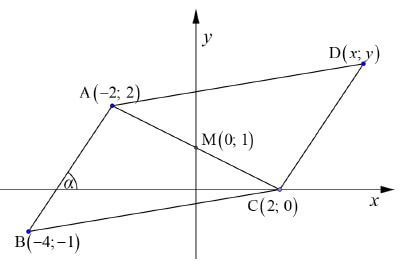
1.1 The length of AB (2)
1.2 The gradient of AB (2)
1.3 The equation of line DC in the form y = mx + c (3)
1.4 The size of α (rounded off to TWO decimal places) (2)
1.5 The y-coordinate of D (2) [11]
QUESTION 2
2.1 In the figure below, O is the centre of the circle. P and Q(12; 5) are two points on the circumference of the circle. POQ is a straight line. The point R lies on the tangent to the circle at Q. 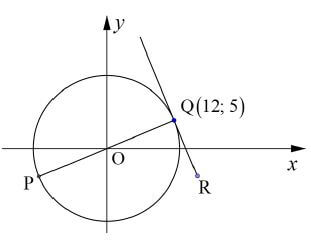
Determine the equation of:
2.1.1 The circle (2)
2.1.2 The tangent RQ in the form y = mx + c (4)
2.2 The equation of an ellipse, with centre at the origin is given by 9x2 + 16y2 = 144
2.2.1 Write down this ellipse equation in standard form (2)
2.2.2 Determine the length of the major axes and the minor axes respectively (2)
2.2.3 Draw on the grid provided, a neat sketch graph of the ellipse. Show ALL intercepts with axes and clearly indicate the major and minor axes (3) [13]
QUESTION 3
3.1 Use a calculator to determine the value of (rounded to 3 decimal places):
cosec2100º
-sec80º
3.2 Simplify to a single trigonometric function:
3.2.1 (7) (4)
(7) (4)
3.3 Prove the identity: (4) [17]
2 = 2cot2θ
secθsec(360º - θ) - tan45º
QUESTION 4
4.1 If 6 sin θ + 4 = 1 and cos θ > 0, draw a diagram on a Cartesian plane, showing the position of θ and evaluate without using a calculator:
4.1.1 tan θ (4)
4.1.2 sin θ + sec θ (3)
4.2 Solve for θ ∈ [0º; 360º], without using a calculator, if: 2sinθ − cosθ = 0 (5) [12]
QUESTION 5
In the diagram below, A, B and L are points on the same horizontal plane.
- HL is a vertical pole of 3 meters high.
- AL = 5,2 m.
- ALB = 113º and angle of elevation of H from B is 40º.
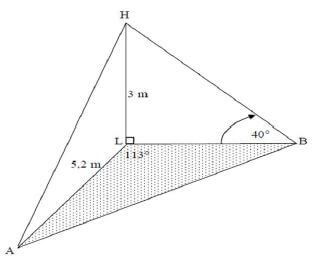
5.1 Determine the size of BHL. (1)
5.2 Calculate the length of LB. (2)
5.3 Hence or otherwise, determine the length of AB. (3)
5.4 Calculate the area of ∆ALB. (3) [9]
QUESTION 6
Given (x) = 2 cos x and g(x) = sin(x − 30°) for x ∈ [0°; 360°]
6.1 Draw the graphs of f and g on the same set of axes. Clearly show the intercepts with the axes as well as the turning points of the graphs. (6)
6.2 Write down the amplitude of f. (1)
6.3 Determine the period of g(x). (1)
6.4 What value(s) of x is g(x) ≤ 0? (4) [12]
Give reasons for ALL your statements in QUESTIONS 7, 8 AND 9. QUESTION 7
7.1 Complete the following theorems by writing down the missing word(s) in each case:
7.1.1 A line drawn from the centre of a circle to the midpoint of a chord, is … to the chord. (1)
7.1.2 Angles opposite equal sides in an isosceles triangle are … (1)
7.1.3 Opposite angles of a cyclic quadrilateral are … (1)
7.2 In the given diagram, O is the centre of the circle. Points A, C, B and E are on the circle. Diameter COE and chord AB intersect at right angles at D.
AD = DB = 15 cm and CD = 6 cm. 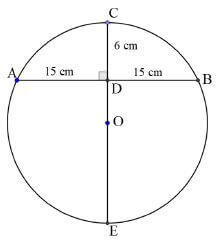
7.2.1 Calculate the length of DO. (4)
7.2.2 Calculate the size of AOB. (3)
7.3 The figure below models the wheel of a sport car with O the central point through which the axle of the car passes. The wheel touches the straight tared surface at point D only.
BC = DC and CDS = 40° 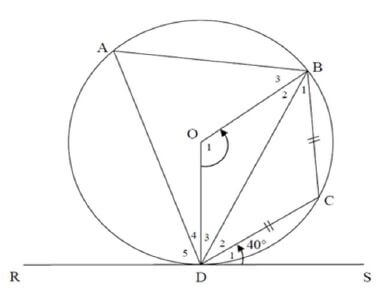
7.3.1 What geometric name is given to RS? Explain your answer. (2)
7.3.2 Determine the size of CDB. (3)
7.3.3 Calculate the size of B2. (3)
7.3.4 Determine the size of Â. (3) [21]
QUESTION 8
8.1 In the figure below, ΔPQR has TM|| QR, PQ = 28 mm and PM : MR = 4 : 3 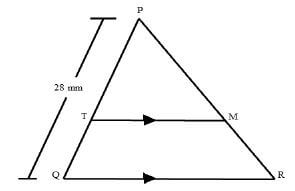
Determine the length of TQ. (4)
8.2 Below is the geometric model of a portion of a roof truss. In the model, ∆ABC has D and E on BC. BD = 6 cm and DC = 9 cm. AT : TC = 2 : 1 and AD // TE. 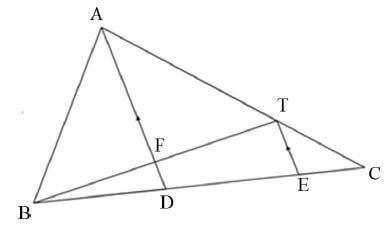
8.2.1 Write down the numerical value of CE/ED .(2)
8.2.2 Show that D is the midpoint of BE. (4)
8.2.3 If FD = 2 cm, calculate the length of TE. (4)
8.2.4 Calculate the numerical value of (3) [17]
Area of ∆ADC
Area of ∆ABD
QUESTION 9
9.1 In the figure below, a circle with centre O and OR ⊥ PT is given. Radius OB = 5 cm and PR = 4 cm. 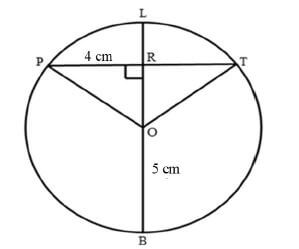
Calculate the heights of the segments of the circle. (5)
9.2 A mechanical technician needs to replace a cross belt on a lath machine as shown in the picture below. The two pulleys have radii of 35 and 85 respectively. The length of the driving belt A to F and C to D, which are points of contacts is 130 cm. 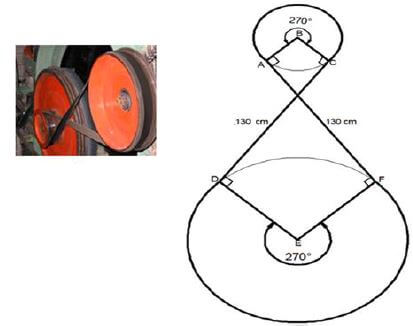
9.2.1 Calculate the length of the major arc DF, to the nearest integer. (4)
9.2.2 If the length of the major arc AC is 165 cm, determine the total length of the driving belt to be replaced. (2)
9.3 A pulley rotates at 420 r/min.
Calculate:
9.3.1 The angular velocity of the pulley in radians per second (4)
9.3.2 The circumferential velocity of the pulley in metres per second, if the diameter of the pulley is 240 mm (5) [20]
QUESTION 10
10.1 Consider the following cylinder and cone. Both objects have the same radius, r cm and height, h cm. ![]()
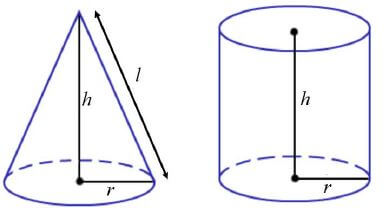
10.1.1 Express the slant height, l of the cone in terms of r and h. (1)
10.1.2 What is the relationship between the volumes of the objects? (1)
10.1.3 If the curved surface area of the cylinder and the cone are the same, πrl = 2πrℎ, show that r2 = 3ℎ2. (2)
10.1.4 Hence, express the volume of the cone in terms of h only. (2)
10.1.5 If the two volumes differ by 54π:
- Show that h = 3 (4)
- Find the value of r (2)
10.2 The map below represents a part of Southern Africa. Ordinates are drawn on the map such that the distance between the ordinates is 110 km. ALL measurements are in kilometres.
y1 | y2 | y3 | y4 | y5 | y6 | y7 | y8 | y9 | y10 | y11 |
430 | 793 | 1167 | 1475 | 1409 | 1431 | 1365 | 1205 | 870 | 529 | 347 |

Determine:
10.2.1 The area of the region represented by the map, using the mid-ordinate rule (3)
10.2.2 The area of the shaded region (3) [18]
TOTAL: 150
INFORMATION SHEET: TECHNICAL MATHEMATICS 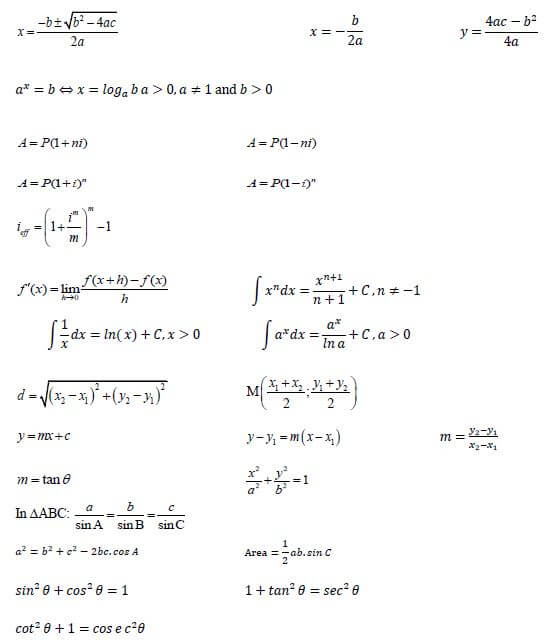
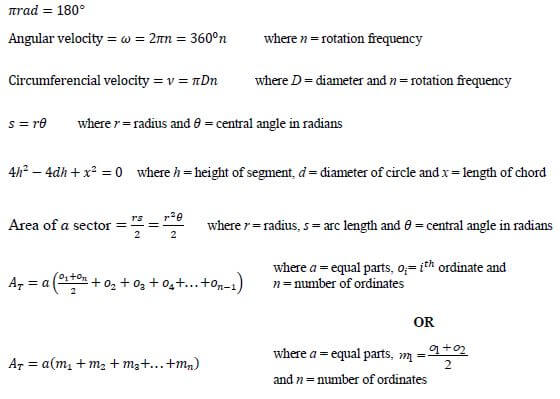
TECHNICAL MATHEMATICS PAPER 1 GRADE 12 QUESTIONS - NSC EXAMS PAST PAPERS AND MEMOS JUNE 2019
TECHNICAL MATHEMATICS
PAPER 1
GRADE 12
NSC EXAMS PAST PAPERS AND MEMOS JUNE 2019
INSTRUCTIONS AND INFORMATION
Read the following instructions carefully before answering the questions.
- This question paper consists of 10 questions.
- Answer ALL the questions.
- Answer QUESTION 3.3 and QUESTION 5.3 on the ANSWER SHEET provided. Write your name in the spaces provided and then hand in the ANSWER SHEET with your ANSWER BOOK.
- Number the answers correctly according to the numbering system used in this question paper.
- Clearly show ALL calculations, diagrams, graphs, etc. that you have used in determining your answers.
- Answers only will not necessarily be awarded full marks.
- You may use an approved scientific calculator (non-programmable and non-graphical), unless stated otherwise.
- If necessary, round off to TWO decimal places, unless stated otherwise.
- Diagrams are NOT necessarily drawn to scale.
- Write neatly and legibly.
QUESTIONS
QUESTION 1
1.1 Solve for x:
1.1.1 2(7x -1)(x + 2) = 0 (2)
1.1.2 (x - 2)(3x - 1) = 1 (correct to TWO decimal places)(4)
1.1.3 -x2 - 4x + 5≥ 0 (3)
1.2 The picture below shows packaged metal sheets by a metal sheet manufacturing company. 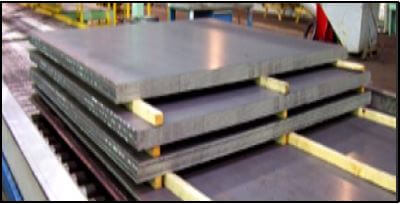
Each pack contains 300 metal sheets and has a thickness of 151 mm.
Determine the thickness (in metres) of one metal sheet in Scientific Notation. (3)
1.3 Given: 2y + 6x = 4 and y2 - 25x2 = 4
1.3.1 Factorise y2 - 25x2 (1)
1.3.2 Hence or otherwise, solve for x and y simultaneously (6)
1.4 Given: M = √ 5 - p ; p∈ {1;2;3;4;5;6}
2
Determine the:
1.4.1 Value(s) of p for which M will be real (2)
1.4.2 Value(s) of p for which M will be non-real (1)
1.5 Describe the nature of the roots of ax2 + bx + c = 0 if a < 0 , b > 0 and c = 0. (2)
1.6 Write 86 as a binary number. (2) [26]
QUESTION 2
2.1 Simplify the following without using a calculator:
2.1.1 3n.34, to a single base term (1)
2.1.2 7.3 n + 2 (2)
3n+4 - 6.3n + 1
2.1.3 √32 - √72 + √18 (2)
2.1.4 -log3243 + log31 (2)
2.2 Solve for x:
2.2.1  (6)
(6)
2.2.2 ![]() (4)
(4)
2.3 Solve for x and y if x + 2yi = (-2 + 6i)(4 - 7i) .(4)
2.4 Write z = √5 - 3i in the form r cisθ (5) [26]
QUESTION 3
Given: ![]()
3.1 Write down the equations of the asymptotes of h. (2)
3.2 Determine the y-intercept of g. (1)
3.3 Sketch the graphs of g and h on the same set of axes on the ANSWER SHEET provided. Clearly show the asymptotes and the intercepts with the axis. (3)
3.4 Write down the domain of h. (1)
3.5 Determine the value(s) of x for which g(x) > h(x). (2) [9]
QUESTION 4
In the diagram drawn below, is a semi-circle defined by ![]() and a tangent to a semi-circle at point P(-3; -3)
and a tangent to a semi-circle at point P(-3; -3)
Determine the:
4.1 Equation of the semi-circle, h (2)
4.2 Equation of the tangent to the semi-circle at P in the form y = … (4)
4.3 Range of h (2) [8]
QUESTION 5
The graph of the function f defined by f(x) = ax2 + bx - 12 intersects the x-axis at x = -2 and x = 6 .
5.1 Show by means of calculations that a = 1 and b = -4 (4)
5.2 Determine the coordinates of the turning point of f. (3)
5.3 Sketch the graph of f on the ANSWER SHEET provided. Clearly show ALL the intercepts with the axis and the turning points of the graph. (4) [11]
QUESTION 6
6.1 Determine the nominal interest rate compounded quarterly if the effective interest rate is 8% per annum. (3)
6.2 In an experiment conducted by learners in a science class, as shown in the picture below, a 90 mm piece of chalk is immersed in a cup containing vinegar to test the effects of an acid on a piece of chalk. The chalk dissolves at a rate of 5% per minute, compound decrease. 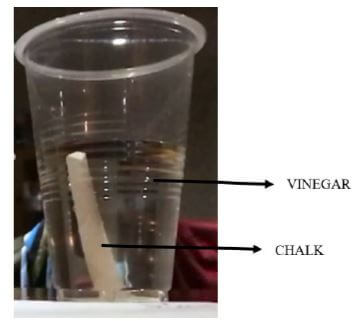
Determine, how long (in minutes) it will take for the chalk to dissolve to half its original length. (5)
6.3 R300 000 is invested at 12% per annum, compound interest for 3 years. After 3 years a deposit of R65 000 is made at 9% per annum compounded quarterly for the remaining 4 years. Calculate how much will be in the account at the end of 7 years. (6) [14]
QUESTION 7
7.1 Determine the derivative of f(x) = 5x - 12 by using FIRST PRINCIPLES. (5)
7.2 Determine:  @ 4
@ 4
7.3
7.3.1 Determine the gradient of a tangent to the graph defined by:
h(x) = 3x2 - 7x + 2 at x = 0,5 (3)
7.3.2 Determine the average gradient of h(x) = 3x2 - 7x + 2 between x = 1 and x = 3 (4) [20]
QUESTION 8
The graph of the function g defined by g(x) = x3 - x is drawn below.
- Points A, (0;0) and B are the intercepts of the graph with the x-axis.
- The y-axis is at the origin.
- K and M are the turning points of g.
Determine the: 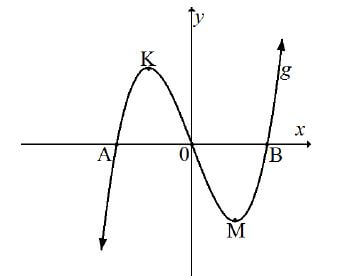
8.1 Coordinates of points A and B (4)
8.2 Coordinates of K and M, the turning points of g (5)
8.3 Value(s) of x for which g'(x) 0 ≤ (3) [12]
QUESTION 9
An oil manufacturing company manufactures cylindrically shaped plastic containers. Each container must hold 275 mℓ of oil. 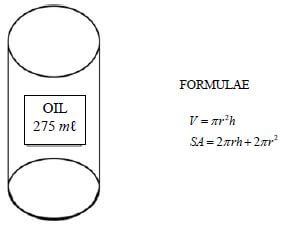
9.1 Write h, the height of the container in terms of r. (3)
9.2 Show that SA = 550 + 2πr2 is the surface area of the container.(3)
r
9.3 Determine r, the radius of the container for which a minimum amount of plastic will be used. (5) [11]
QUESTION 10
10.1 Determine the integral: ![]()
10.2 The graph of f defined by f(x) = - x3 + 6x2 is drawn below.
Determine: 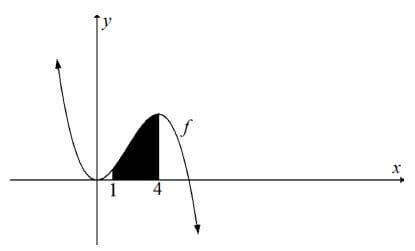
10.2.1 ![]() (3)
(3)
10.2.2 The area of the shaded region of the graph of f bounded by the graph and the x-axis, between x = 1 and x = 4. (5) [13]
TOTAL: 150
Name: ………………………….………….
School: …………………………………….
QUESTION 3.3 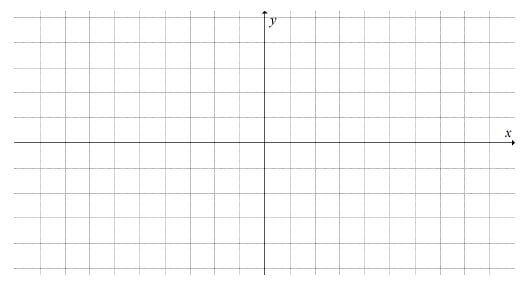
QUESTION 5.3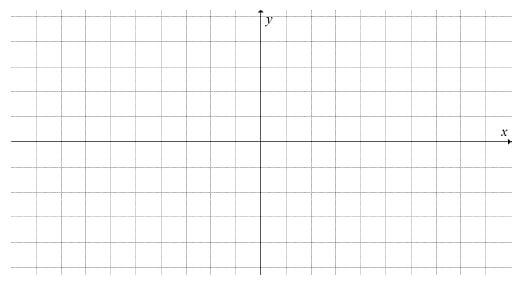
INFORMATION SHEET: TECHNICAL MATHEMATICS 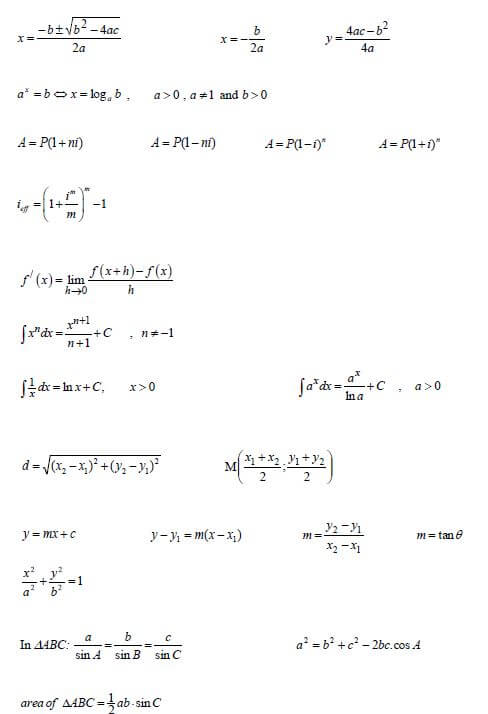
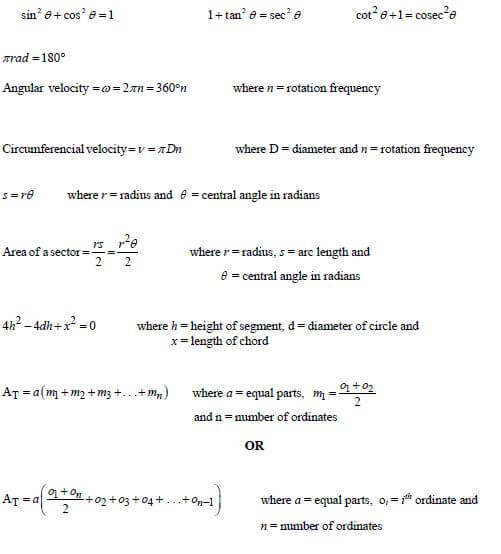
TECHNICAL MATHEMATICS PAPER 1 GRADE 12 MEMORANDUM - NSC EXAMS PAST PAPERS AND MEMOS JUNE 2019
TECHNICAL MATHEMATICS
PAPER 1
GRADE 12
NSC EXAMS
PAST PAPERS AND MEMOS JUNE 2019
Marking Codes | |
A | Accuracy |
CA | Consistent accuracy |
M | Method |
R | Rounding |
NPR | No penalty for rounding |
NPU | No penalty for units omitted |
S | Simplification |
SF | Substitution in the correct formula |
NOTE:
- If a candidate answers a question TWICE, only mark the FIRST attempt.
- If a candidate has crossed out an attempt of a question and not redone the question, mark the crossed-out version.
- Consistent accuracy (CA) applies to ALL aspects of the marking guideline.
- Assuming answers/values to solve a problem is NOT acceptable.
MEMORANDUM
QUESTION 1 | ||||
1.1 | 1.1.1 | (7x - 1)(x + 2) = 0 | ✓ x = 1/7 A | (2) |
1.1.2 | (x - 2)(3x - 1) = 1 3x2 - 7x + 1 = 0 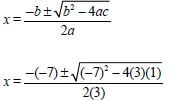 x = 2,18 or x = 0,15 | ✓Simplification/Standard Form A | (4) | |
1.1.3 | -x2 - 4x + 5 ≥ 0 | ✓Factors/ Substitution in the quadratic formula M A | (3) | |
1.2 | Total thickness of the pack = 151 ÷ 1 000 = 0,151 m | ✓Conversion A | (3) | |
1.3 | 1.3.1 | (y - 5x)(y + 5x) | ✓Factors A | (1) |
1.3.2 | 2y + 6x = a and y2 - 25x2 = 4 y = -3x + 2 substitute y into y2 - 25x2 = 4 (-3x + 2)2 - 25x2 - 4 = 0 9x2 - 12x + 4 - 25x2 - 4 = 0 -16x2 - 12x = 0 -x(16x + 12) = 0 x = 0 or 16x = -12 x = 0 or x = 12/16 = 3/4 if x = 0 then y = 2 if x = 3/4 then = 17/4 | ✓y - the subject A | (6) | |
1.3.2 | OR | ✓y - the subject A | ||
1.4 | 1.4.1 | p ∈{1;2;3;4;5} | ✓✓All 5 correct values A | (2) |
1.4.2 | p = 6 | ✓6 A | (1) | |
1.5 | Real, rational and unequal | ✓Real and unequal A | (2) | |
1.6 | 86 = 26 + 24 + 22 + 21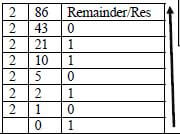 - 1 mark of base 2 is not written | ✓Method M | (2) | |
[26] | ||||
QUESTION 2 | ||||
2.1 | 2.1.1 | 3n.34 = 3n+4 | ✓3n+4 A | (1) |
2.1.2 |  | ✓Factors S ✓Simplification S CA | (2) | |
2.1.3 | √32 - √72 + √18 | ✓Simplification S | (2) | |
2.1.4 | -log3243 + log31 | ✓0 A | (2) | |
2.2 | 2.2.1 |  42x2 - 3 - x = 4º 2x2 - x - 3 = 0 (2x - 3)(x + 1) = 0 x = 3/2 or x = −1 | ✓Power rule A | (6) |
2.2.2 | x = log 6 - log 2 or x = log 6 - log 2 | ✓Log law | (4) | |
2.3 | x + 2yi = (-2 + 6i)(4 - 7i) | ✓Expansion S | (4) | |
2.4 |
| ✓Finding r SF | (5) | |
[26] | ||||
QUESTION 3 | |||
3.1 | x = 0 and y = 0 | ✓x = 0 A | (2) |
3.2 | y =1 | ✓ y = 1 A | (1) |
3.3 |
| ✓Shape g A | (3) |
3.4 | x ≠ ∈ 0,x R | ✓ x ≠ 0,x R ∈ CA | (1) |
3.5 | x < of x > −1 or / 0 | ✓x<−1 CA | (2) |
[9] | |||
QUESTION 4 | ||||
4.1 |
| ✓Value of SF | (2) | |
4.2 | m = -3 = 1 | ✓m of the line through origin and P A | (4) | |
4.3 |
| ✓✓Accurate answer A | (2) | |
[8] | ||||
QUESTION 5 | |||
5.1 | f(x) = ax2 + bx - 12 OR f(-2) = a(-2)2 + b(-2) - 12 = 0 | ✓Substitution SF | (4) |
5.2 | f(x) = x2 - 4x - 12 | ✓Method M | (3) |
OR | |||
OR | |||
5.3 |
| ✓x-intercepts A | (4) |
[11] |
QUESTION 6 | |||
6.1 |
| ✓Formula A | (3) |
6.2 | A = P(1 -i)n | ✓Formula A | (5) |
6.3 | A = P(1 -i)n | ✓Formula A | (6) |
OR | ✓Formula A | ||
[14] | |||
QUESTION 7 | ||||
NOTE : Deduct 1 mark for incorrect notation from 7.1 to 7.2.2 LET WEL: Trek 1 punt af vir inkorrekte notasie van 7.1 tot 7.2.2 | ||||
7.1 |
| ✓Formula A | (5) | |
7.2 | 7.2.1 |
| ✓ 2x−2 A | (4) |
7.2.2 | ✓x A | (4) | ||
7.3 | 7.3.1 | h(x) = 3x2 - 7x + 2 h'(x) = 6x - 7 h'(0,5) = 6(0,5) - 7 mtangent = -4 | ✓6x - 7 A | (3) |
7.3.2 | h(x) = 3x2 - 7x + 2 | ✓−2 A | (4) | |
[20] | ||||
QUESTION 8 | ||||
8.1 | g(x) = x3 - x | ✓Substitution by 0 SF | (4) | |
8.2 |
| ✓Derivative A | (5) | |
8.3 | −0,58 ≤ x ≤ 0,58 | ✓−0,58 CA | (3) | |
[12] | ||||
QUESTION 9 | |||
9.1 | V = πr2h | ✓Formula A | (3) |
9.2 | SA = 2πrh + 2πr2 SA = 2πr × 275 + 2πr2 πr2 SA = 550 + 2πr2 r | ✓Formula A | (3) |
9.3 |
| ✓ 550r-1 A | (5) |
[11] | |||
QUESTION 10 | ||||
10.1 |
| ✓Simplification A | (5) | |
10.2 | 10.2.1 |
| ✓ - x4 A | (3) |
10.2.2 |
| ✓A definite integral formula A | (5) | |
[13] | ||||
TOTAL: | 150 | |||
TECHNICAL MATHEMATICS PAPER 2 GRADE 12 MEMORANDUM - NSC EXAMS PAST PAPERS AND MEMOS JUNE 2019
TECHNICAL MATHEMATICS
PAPER 2
GRADE 12
NSC EXAMS
PAST PAPERS AND MEMOS JUNE 2019
NOTE:
- Continuous accuracy (CA) applies in ALL aspects of the marking guideline.
- Assuming values/answers in order to solve a problem is unacceptable.
MARKING CODES | |
M | Method |
MA | Method with accuracy |
A | Accuracy |
CA | Consistent accuracy |
S | Simplification |
SF | Substitution into the correct formula |
R | Rounding penalty |
RE | Reason |
ST | Statement |
SR | Statement and correct reason |
MEMORANDUM
QUESTION 1 | |||
| |||
1.1 |
| ✔ SF/A | (2) |
1.2 | mAB = 2-(-1) | ✔ SF/A | (2) |
1.3 | mCD = mAB = 3/2 AB ? CD | ✔ ST | (3) |
1.4 |  | ✔M | (2) |
1.5 | 1 = yD - 1 2 yD - 1 = 2 yD = 3 | ✔M | (2) |
[11] | |||
QUESTION 2 | |||
| |||
2.1.1 | x2 + y2 = r2 | ✔SF/A | (2) |
2.1.2 | mPQ = 5 | ✔A gradient PQ | (4) |
2.2.1 | 9x2 + 16y2 = 144 | ✔A LHS/LK ✔A RHS/RK = 1 | (2) |
2.2.2 | Major axis = 8 Minor axis = 6 | ✔CA | (2) |
2.2.3 |
| ✔CA both x-intercepts/ | (3) |
[13] | |||
QUESTION 3 | |||
3.1 | cosec100 ° | ✔✔A R | (2) |
3.2.1 |
| ✔A (-tan θ) | (7) |
3.2.2 |
| ✔A cos x | (4) |
3.3 |
| ✔A tan 45° = 1 | (4) |
[17] | |||
QUESTION 4 | |||
4.1.1 |
| ✔A sin θ S | (4) |
4.1.2 |
| ✔CA −½ | (3) |
4.2 | 2sinθ - cosθ = 0 | ✔A tanθ = ½ | (5) |
[12] | |||
QUESTION 5 | |||
| |||
5.1 | BHL = 180º - (90º + 40º) | ✔A | (1) |
5.2 | In BHL | ✔M | (2) |
5.3 |
| ✔M | (3) |
5.4 | ΔALB = ½AL × LB.sinALB | ✔M | (3) |
[9] | |||
QUESTION 6 | |||
6.1 | f(x) = 2 c0s x and g(x) = sin(x - 30º) | ||
| f: | (6) | |
6.2 | Amplitude f = 2 | ✔A | (1) |
6.3 | Period g = 360° | ✔A | (1) |
6.4 | x∈(0º;30º) or x∈[210º;360º] | ✔CA end points | (4) |
[12] | |||
QUESTION 7 | |||
7.1.1 | Perpendicular | ✔A | (1) |
7.1.2 | Equal | ✔A | (1) |
7.1.3 | Supplementary | ✔A | (1) |
7.2 |
| ||
7.2.1 | Let DO = x cm | ✔M Apply Pyth | (4) |
7.2.2 | tanDOB = 15 | ✔M | (3) |
7.3 |
| ||
7.3.1 | RS is a tangent, because it touches the surface at one point only. | ✔A tangent | (2) |
7.3.2 | DBC = 40º tan-chord thm | ✔ST ✔RE | (3) |
7.3.3 | D3 = 90º - (D2 + D1) tan⊥rad | ✔ST ✔RE | (3) |
7.3.4 | BDS = 80º | ✔ST | (3) |
[21] | |||
QUESTION 8 | |||
| |||
8.1 | TQ = MR prop theorem; TM//QR | ✔ST | |
| |||
8.2.1 | CE = 1 prop theorem; TE//AD | ✔ST | (2) |
8.2.2 | DE = AT = 2 prop theorem; AD//TE | ✔SR ✔RE ✔S | (4) |
8.2.3 | BD = DE D as mid-pt BE, proved | ✔ST ✔RE | (4) |
8.2.4 |
| ✔M | (3) |
[17] | |||
QUESTION 9 | |||
9.1 | 4h2 - 4dh + x2 = 0 4h2 - 4(10)h + 82 = 0 4h2 - 40h + 64 = 0 h2 - 10h + 16 = 0 (h - 2)(h - 8) = 0 h = 2cm & 8cm | ✔ A formula | (5) |
| |||
9.2.1 | s = rθ
| ✔A formula | (4) |
9.2.2 | Length of belt = 165 + 130 × 2 + 401 = 826 cm | ✔M | (2) |
9.3.1 |
| ✔A formula | (4) |
9.3.2 | 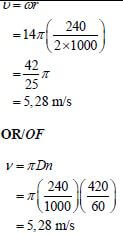 | ✔A formula | (5) |
[20] |
QUESTION 10 | |||
10.1.1 |
| ✔A | (1) |
10.1.2 | Volcone = 1 Volcylinder or Volcylinder = 3Volcone | ✔A | (1) |
10.1.3 |
| ✔ST | (2) |
10.1.4 | Vcone = 1 πr2h | ✔A SF ✔S | (2) |
10.1.5(a) |
| ✔M ✔A SF ✔S ✔S | (4) |
10.1.5(b) | r2 = 3h2 | ✔ A SF | (2) |
10.2.1 |
| ✔A formula | (3) |
10.2.2 | Shaded region = Tot_rect_region - map_region | ✔ A Area total region ✔ CA Area | (3) |
[18] | |||
TOTAL: | 150 |
MATHEMATICAL LITERACY PAPER 2 GRADE 12 ADDENDUM - NSC EXAMS PAST PAPERS AND MEMOS JUNE 2019
MATHEMATICAL LITERACY
PAPER 2
GRADE 12
NSC EXAMS
PAST PAPERS AND MEMOS JUNE 2019
ADDENDUM
ANNEXURE A: QUESTION 1
Tuition Fee Account
MISS NANCY DAWN | STUDENT No./STUDENTE NR. 2017089382 | 05/03/2018 |
DEGREE/GRAAD | ||
BA (CS)CMC | ||
ACCOUNT NO./REKENING NR. | ||
2015089382 |
DATE | DATE DUE | COURSE CODE | DESCRIPTION | DEBIT | CREDIT |
26/01/2018 | 31/12/2017 | OPENING BALANCE | 2 696.94 | ||
16/02/2018 | 31/03/2018 | BKT 214 | DR-TUT FEE 1ST SEMESTER BFN | 3 715.00 | |
16/02/2018 | 31/03/2018 | KOM 214 | DR-TUT FEE 1ST SEMESTER BFN | 3 715.00 | |
16/02/2018 | 31/03/2018 | KOM 234 | DR-TUT FEE 1ST SEMESTER BFN | 3 715.00 | |
16/02/2018 | 31/03/2018 | BKO 234 | DR-TUT FEE 1ST SEMESTER BFN | 3 715.00 | |
16/02/2018 | 31/03/2018 | EBUS2714 | DR-TUT FEE 1ST SEMESTER BFN | 4 280.00 | |
16/02/2018 | 31/03/2018 | EBUS2715 | DR-TUT FEE 1ST SEMESTER BFN | A . | |
16/02/2018 | 31/08/2018 | EBMA2624 | DR-TUT FEE 2ND SEMESTER BFN | 3 510.00 | |
16/02/2018 | 31/08/2018 | BKO 244 | DR-TUT FEE 2ND SEMESTER BFN | 3 715.00 | |
16/02/2018 | 31/08/2018 | BKO 264 | DR-TUT FEE 2ND SEMESTER BFN | 3 715.00 | |
16/02/2018 | 31/08/2018 | KOM 224 | DR-TUT FEE 2ND SEMESTER BFN | 3 715.00 | |
16/02/2018 | 31/08/2018 | ESBM2724 | DR-TUT FEE 2ND SEMESTER BFN | 4 280.00 | |
16/02/2018 | 31/03/2018 | DR-CAMPUS LEVY | 210.00 | ||
16/02/2018 | 31/03/2018 | DR-REGISTRATION FEE | 1 020.00 | ||
21/02/2018 | CR-ACADEMIC BURSARY BFN | 2 188.00 | |||
02/03/2018 | 01/04/2018 | BKT 214 | DR-STUDY GUIDE BFN | 25.21 | |
02/03/2018 | 01/04/2018 | EBUS2714 | DR-STUDY GUIDE BFN | 14.40 | |
BALANCE | 45 198.55 | ||||
OVERDUE | CURRENT | PAYABLE NOW | ||||||||||
508.94 | 25 754.61 | 26 263.55 | ||||||||||
FEB | MAR | APR | MEI | JUN | JUL | AUG | SEP | OCT | NOV | DEC | Other | FUTURE PAYMENTS |
18 935 | 18 935.00 | |||||||||||
Students receiving financial aid remain responsible for payment of sthe amount shown as’ PAYABLE NOW’’
ANNEXURE B: QUESTION 2.1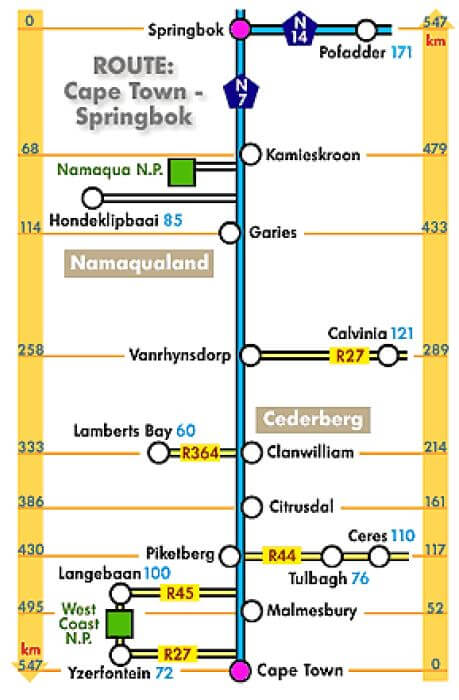
ANNEXURE C: QUESTION 3.1
ABSA PREMIER SOCCER LEAGUE
Rank | Team | Played | Won | Lost | Drawn | Points |
1 | Orlando Pirates | 14 | 6 | 2 | 6 | A |
2 | Wits | 12 | 7 | 3 | 2 | 23 |
3 | Mamelodi Sundowns | 11 | 5 | 0 | 6 | 21 |
4 | Bloemfontein Celtic | 12 | 6 | 3 | 3 | 21 |
5 | Polokwane City | 13 | 6 | 4 | 3 | 21 |
6 | Supersport United | 12 | B | 3 | 4 | 19 |
7 | Kaizer Chiefs | 14 | 4 | 4 | 6 | 18 |
8 | Cape Town City | 12 | 4 | 4 | 4 | 16 |
9 | Highlands Park | 12 | 3 | 3 | 6 | 15 |
10 | Golden Arrows | 13 | 3 | 4 | 6 | 15 |
11 | Free State Stars | 14 | 3 | 7 | 4 | 13 |
12 | Maritzburg United | 11 | 1 | 3 | 7 | 10 |
13 | AmaZulu | 12 | 4 | 4 | 4 | 10 |
14 | Baroka FC | 12 | 2 | 6 | 4 | 10 |
15 | Chippa United | 12 | 2 | 6 | 4 | 10 |
16 | Black Leopards | 12 | 2 | 7 | 3 | 9 |
ANNEXURE D: QUESTION 4.1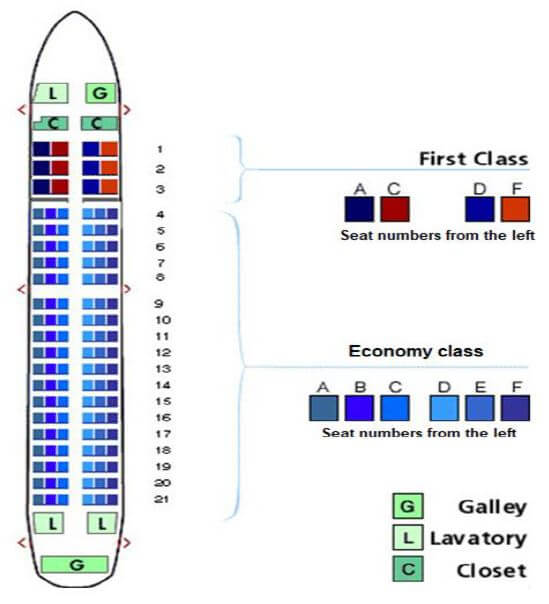
ANNEXURE E: QUESTION 4.2
TICKET COSTS FOR WIMBLEDON TENNIS CHAMPIONSHIPS IN 2007 AND 2019